We’re thrilled to welcome Scott Rosenberg to our ‘Think Tank’
A proven builder and industry veteran, Scott strengthens our mission to deliver smarter, faster, and more impactful outcomes for our clients.
Welcome to HEX, Scott!
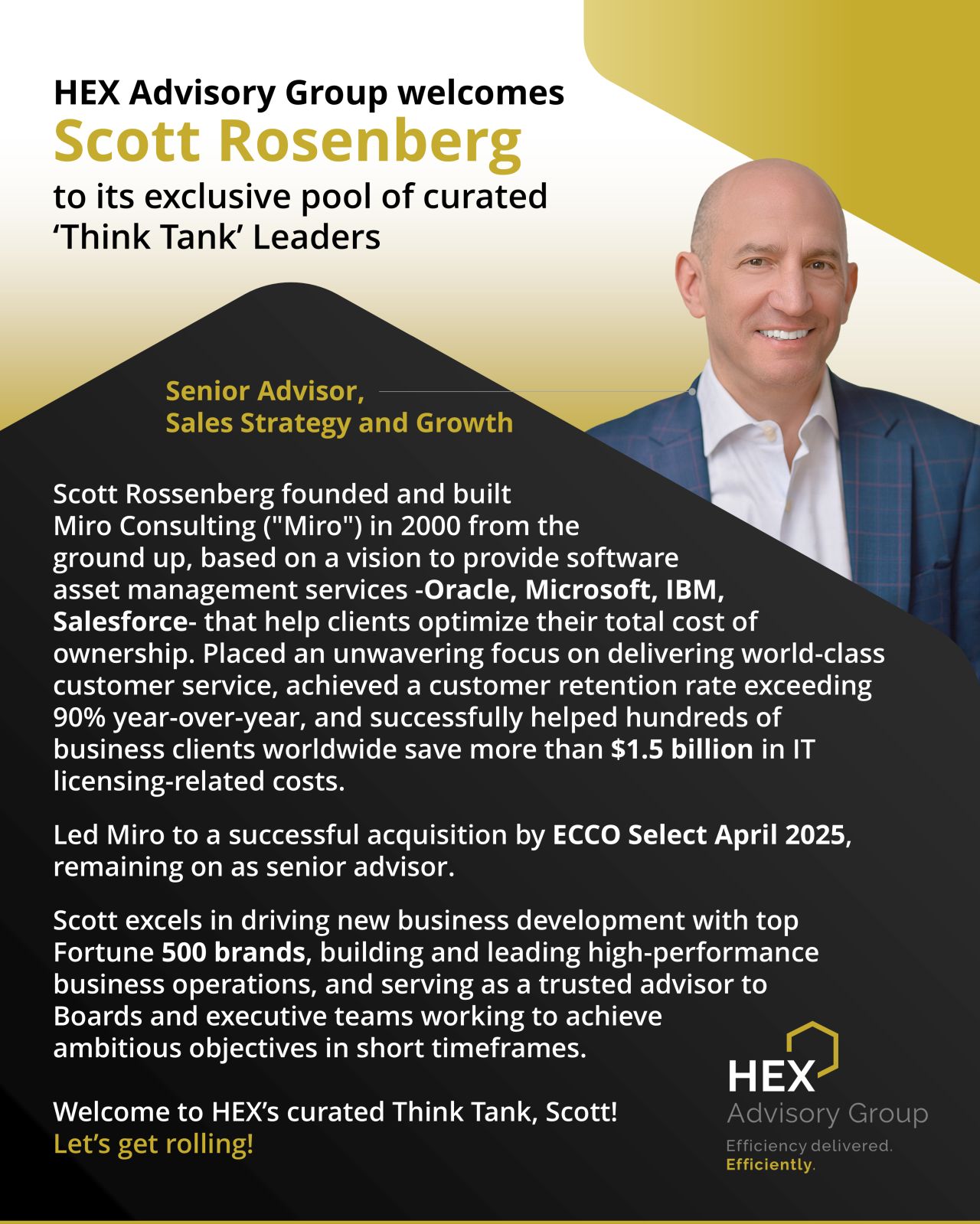
We’re thrilled to welcome Scott Rosenberg to our ‘Think Tank’
A proven builder and industry veteran, Scott strengthens our mission to deliver smarter, faster, and more impactful outcomes for our clients.
Welcome to HEX, Scott!

Cost efficiency is table stakes.
Outcome efficiency is competitive advantage.
When trust deepens, pricing shifts — from counting hours to counting impact delivered.
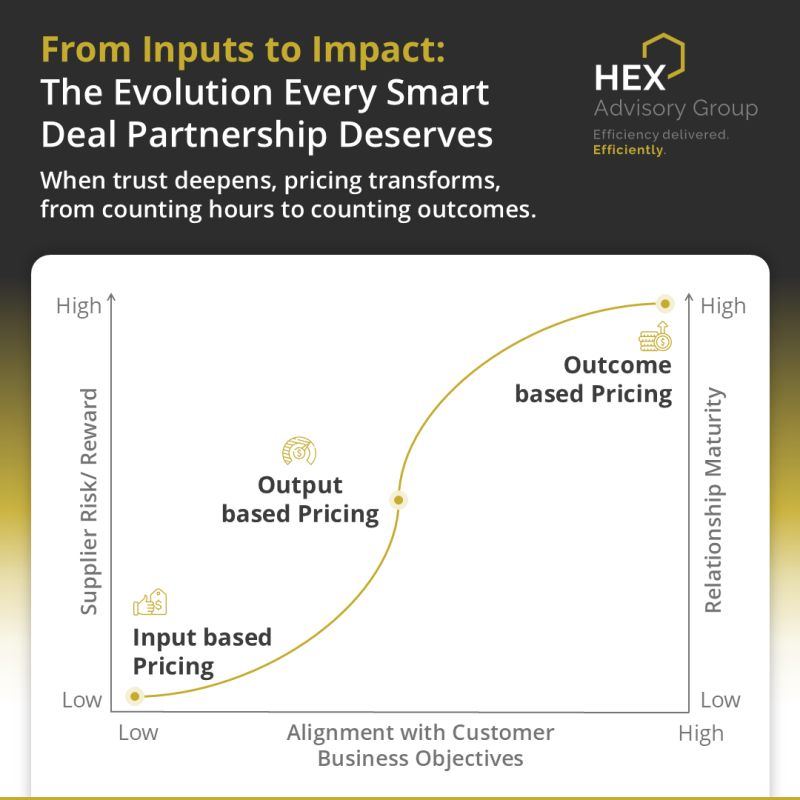
Anyone can rubberstamp your plan. We’d rather pressure-test it.
That’s how real outcomes are born.

Presenting Part 6 of our series — “Executive Cheat Sheet on T&Cs” — your no-fluff guide to Contracting 101. We break down dense terms and conditions into what they actually mean, why they matter, and how they impact your IT and BPO deals.

Source: LinkedIn
Imagine the conviction it takes for a CIO, CTO, CFO, or COO to choose HEX Advisory Group over the comfort of Big Consulting. Grateful to the contrarians who do—your trust fuels our fire to redefine IT BPO GCC sourcing.

The US-based Southwest Airlines has announced plans to set up its global innovation centre (GIC) in Hyderabad after a team of the airline management met Chief Minister A Revanth Reddy in Secretariat on Thursday.
Expressing delight over the company’s announcement, Revanth Reddy briefed them about the state government’s ambitious vision for Telangana to achieve a $1-trillion economy by 2034 and a $3-trillion economy by 2047, as part of the state’s “Telangana Rising 2047” vision. Roads and buildings minister Komatireddy Venkat Reddy was present in the meeting.
The team from Southwest Airlines, the fourth largest US carrier by passengers carried, included its chief information officer Lauren Woods, chief technology officer Tom Merritt, Jason Shying, head, legal counsel, and Sarthak Brahma from HEX Advisory Group.
The Chief Minister welcomed the senior leadership from Southwest Airlines who have chosen to launch their global innovation centre in Hyderabad to support the evolution of their business strategy.
Source: Deccan Chronicle
This Diwali, we shared smiles, sweets, and moments that brought us closer as a team. Here’s to spreading positivity, empowering one another, and lighting the way to new successes.
Wishing everyone a bright and prosperous Diwali!
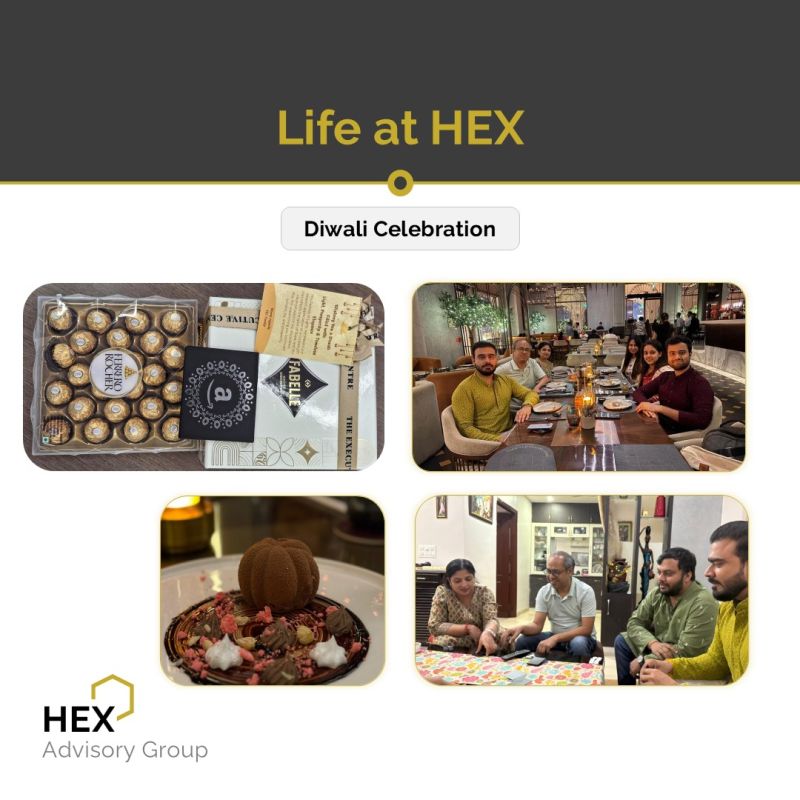
Source: LinkedIn
The rise of GCC-as-a-Service marks a shift from displacement to strategic evolution, where Indian IT firms co-create success with global enterprises.
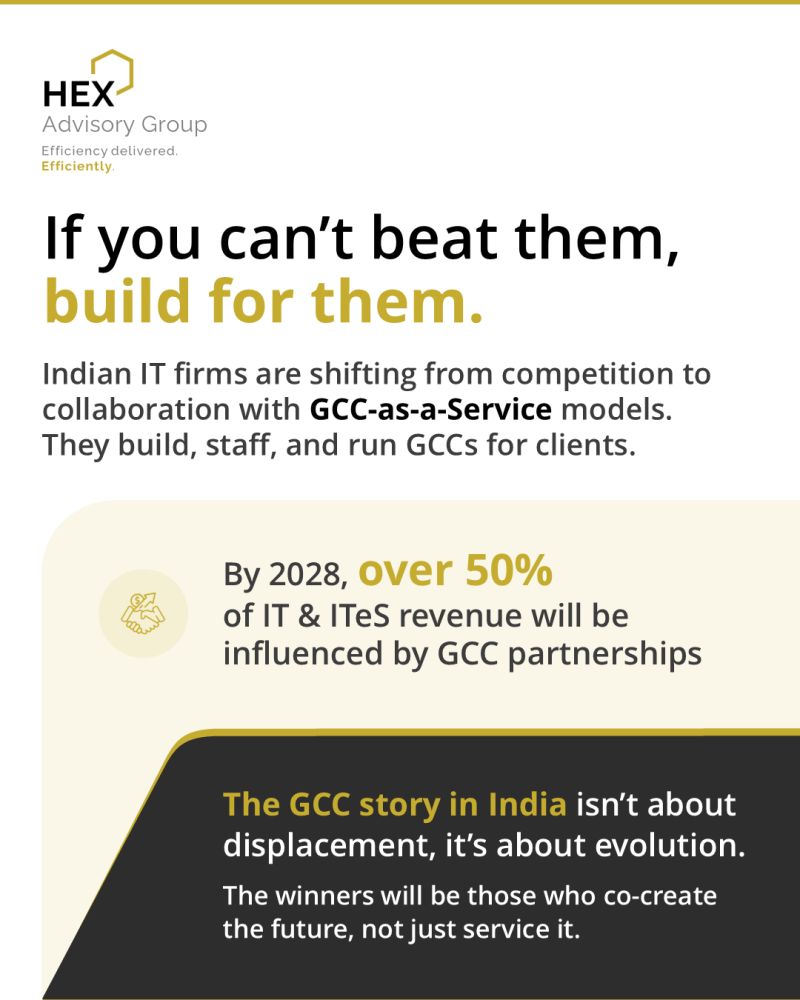
Source: LinkedIn
The old math of pricing doesn’t add up anymore.
Today, value isn’t about hours billed, it’s about outcomes delivered.
Is your enterprise still paying for effort, or for impact?
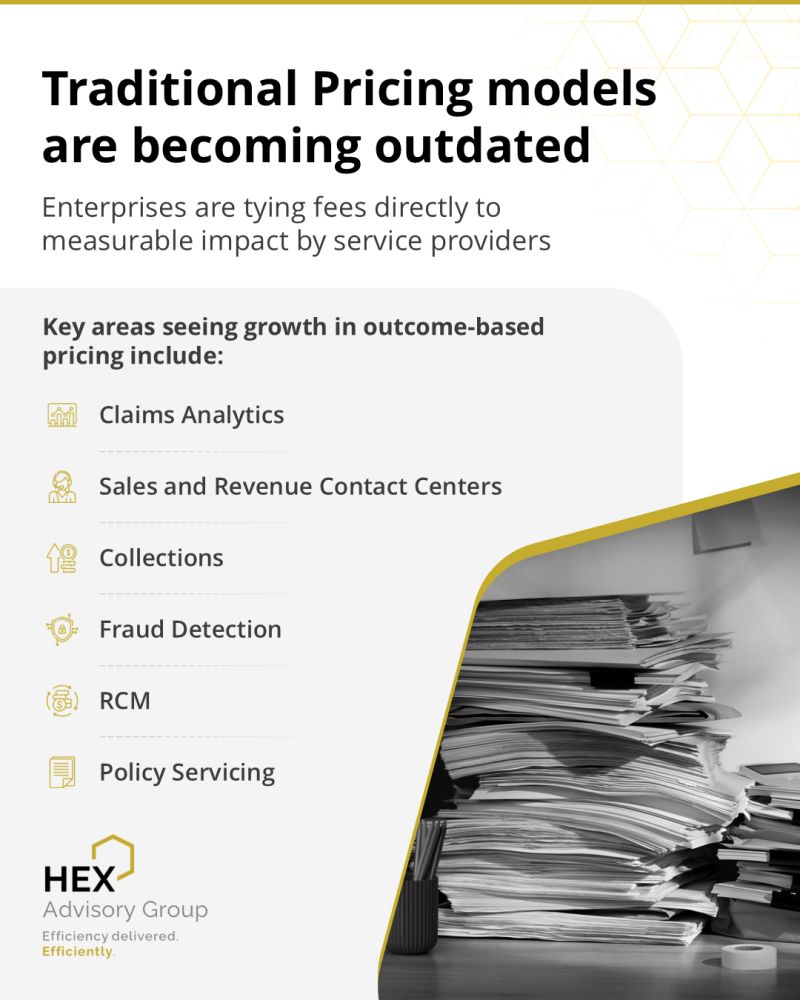
Source: LinkedIn
As metro primes get saturated, value shifts to the periphery.
Mid-size and PE-backed firms are realizing that India’s emerging cities offer not just cost efficiency but a strategic advantage.
Source: LinkedIn
Tech isn’t just a vendor expense anymore. It’s a core muscle. Smart enterprises aren’t debating outsourced vs in-house. They’re asking what to own and where to build.
Enterprises are reshaping their IT portfolio strategies by complementing third-party contracts with Global Capability Centers (GCCs).
A strong vendor relationship should provide the flexibility to carve out GCCs on enterprise-defined terms, backed by:
Source: LinkedIn
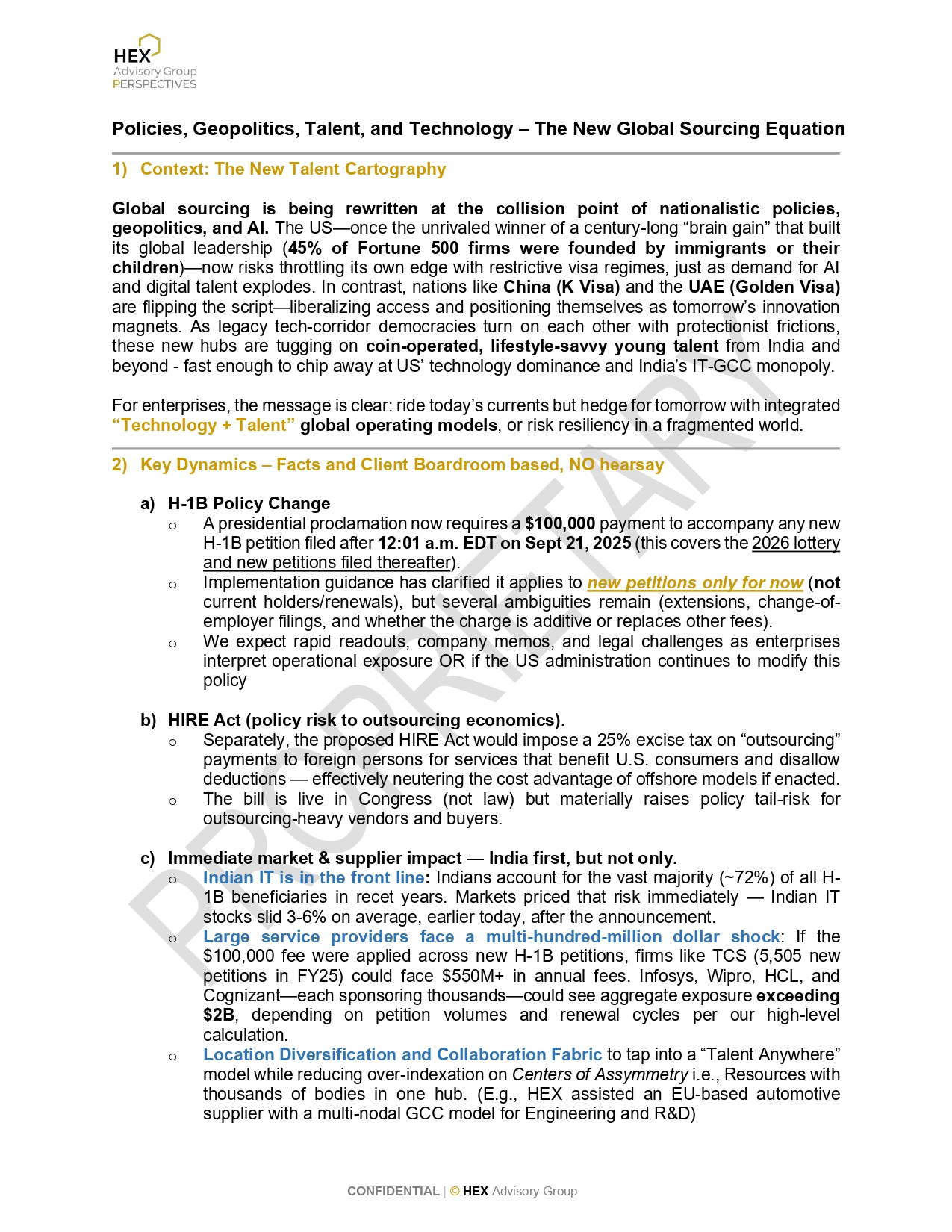
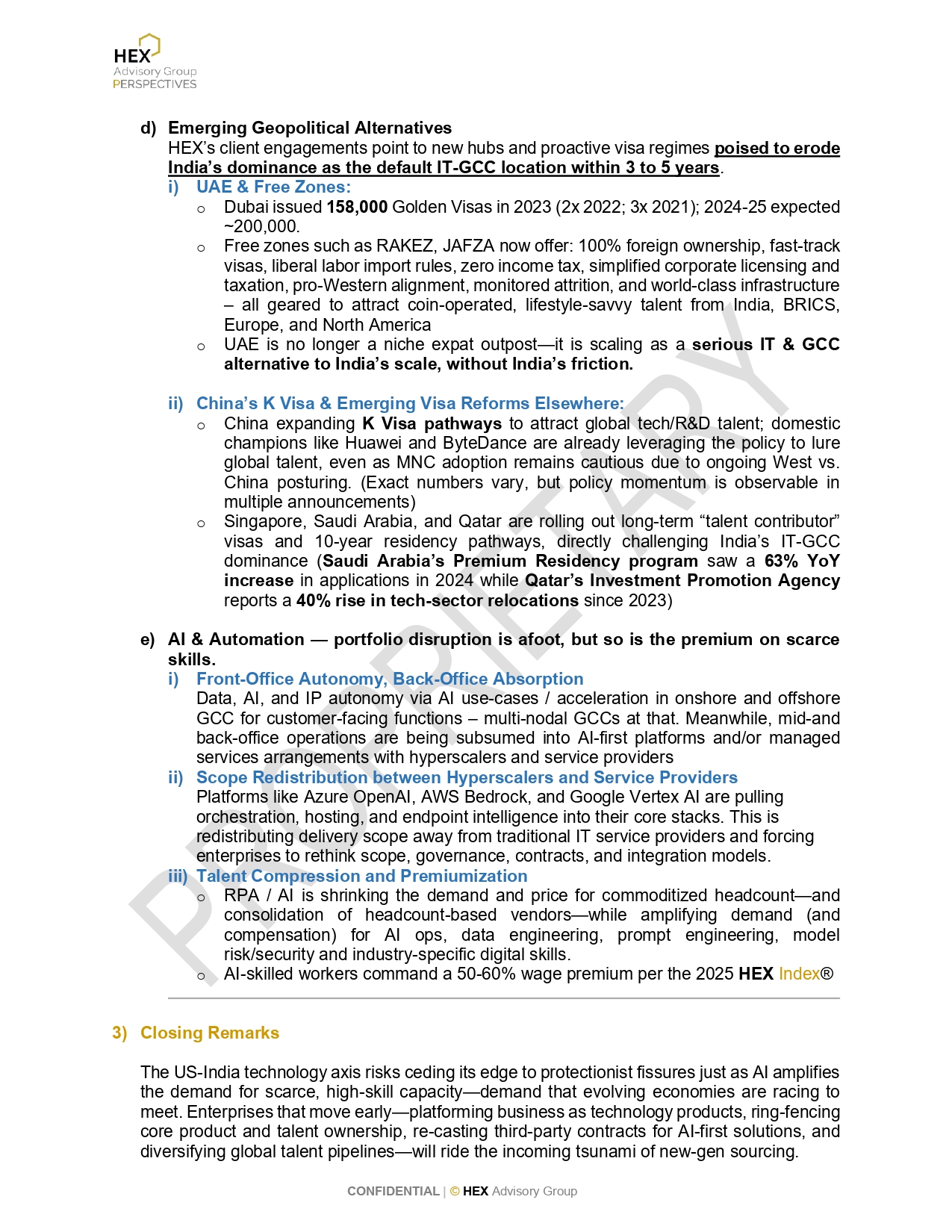
The new H1B policy, the HIRE Act, nationalistic geopolitics, and AI-driven disruption are colliding to redraw the Global Sourcing map. Tectonic shifts like these often spawn ecosystems that profit from fear and rhetoric.
HEX Advisory Group shares what’s truly happening and it’s impact in a 2-page Boardroom Brief—fact-based, first-hand client advisory intelligence on the New Global Sourcing Order.
SYNOPSIS: The race for Technology & Talent sovereignty is on. Over the next 3–5 years, the Global Talent Migration map will be redrawn. Will the US-India IT and GCC axis crack faster than naivete leads us to believe?
Source: LinkedIn
From disruption to growth, GCCs are rewriting the outsourcing playbook with two new centers born in India every week.
At HEX, we’ve been on the frontlines, helping enterprises design GCCs that deliver beyond cost advantage.
Source: LinkedIn
Hype fades. Reality delivers. Stay tuned to HEX Perspectives that keep enterprises grounded in results, not buzzwords.
Source: LinkedIn
In sourcing, theory doesn’t cut it, callused hands do.
This year, HEX delivered 40–60% efficiencies across:
/ AI-first SmartDesk
/ ITAMaaS
/ Agentic SAP S/4HANA
/ GCC TOM, Scoping, Business Case, Real Estate & Govt liaisoning, Talent Execution
/ EDGE IoT SOC/NOC Managed Services
ALL from the trenches.
We win large, confidential mandates against Big Consulting for one reason: We know HOW.
Source: LinkedIn
When a major airline went shopping for a next-gen Service Desk or “Smart Desk”, most vendors pitched GenAI as a wrapper. Only one showed how it would actually transform service delivery. That clarity turned a bid into a win.
Source: LinkedIn
You can’t outfly inflation, tariffs, or union strikes.
But you can outsmart them.
Efficiency isn’t a buzzword, it’s the survival kit your margins are begging for.
At HEX, we help airlines and logistics leaders smooth the turbulence with efficiency-led strategies that keep margins flying high.
Source: LinkedIn
Shaping India’s Semiconductor Future | HEX at Semicon India 2025
Earlier this week, HEX Advisory Group had the privilege of attending the Semicon India Summit 2025 (2nd–4th Sept) in Delhi, invited by our partners at Tata Consultancy Services.
TCS showcased the “Design to Device” vision as part of the broader Tata Electronics strategy, highlighting how India is moving towards becoming a fully integrated semiconductor hub.
If TATA Electronics succeeds in driving design, manufacturing, assembly & testing all within India, it would make India the first country in the world to achieve complete end-to-end semiconductor capability domestically.
The ambition is bold: to build in India, for the world.
We left the summit inspired, India’s semiconductor journey is not just about technology, but about self-reliance, global competitiveness, and shaping the future of electronics.
Source: LinkedIn

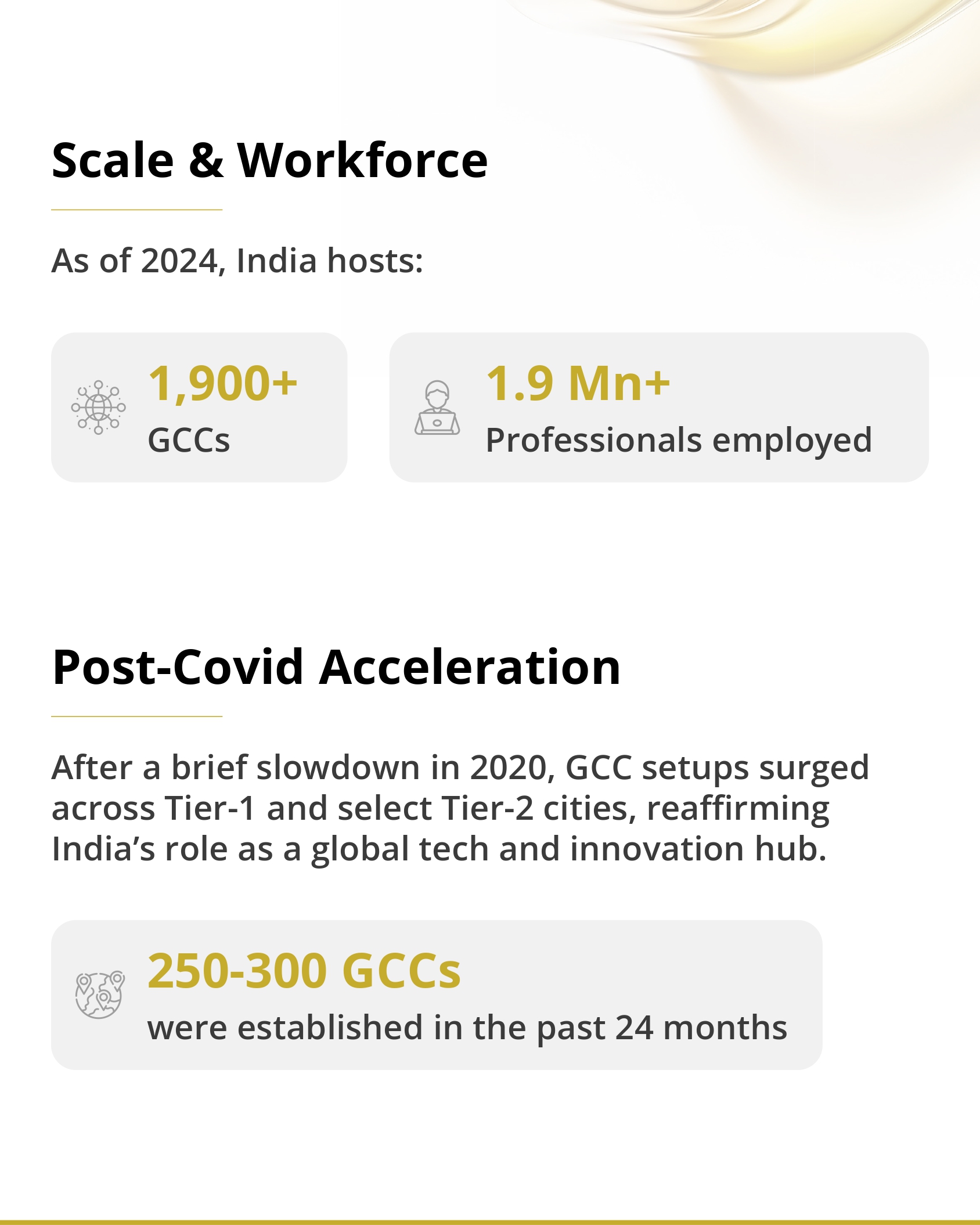
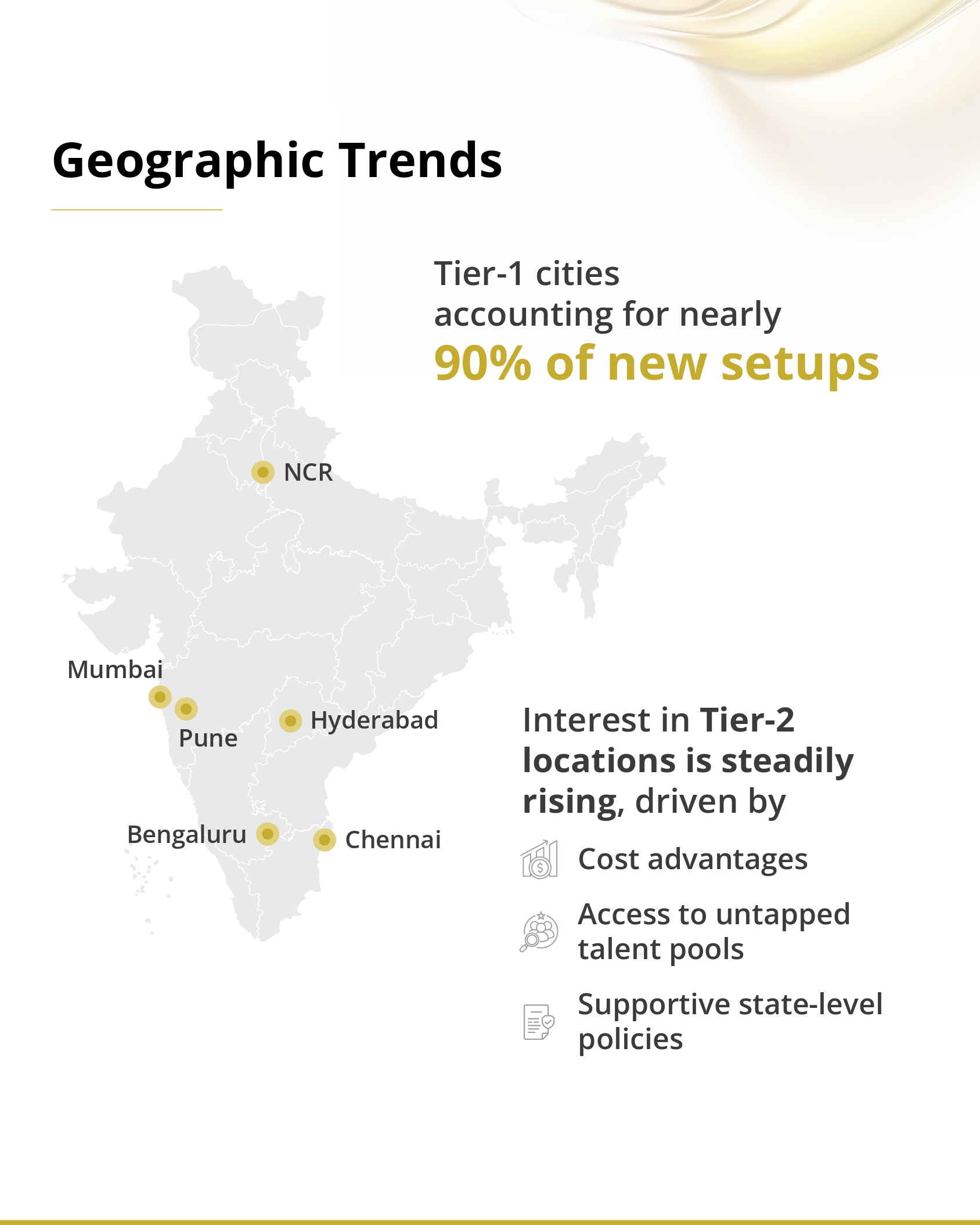

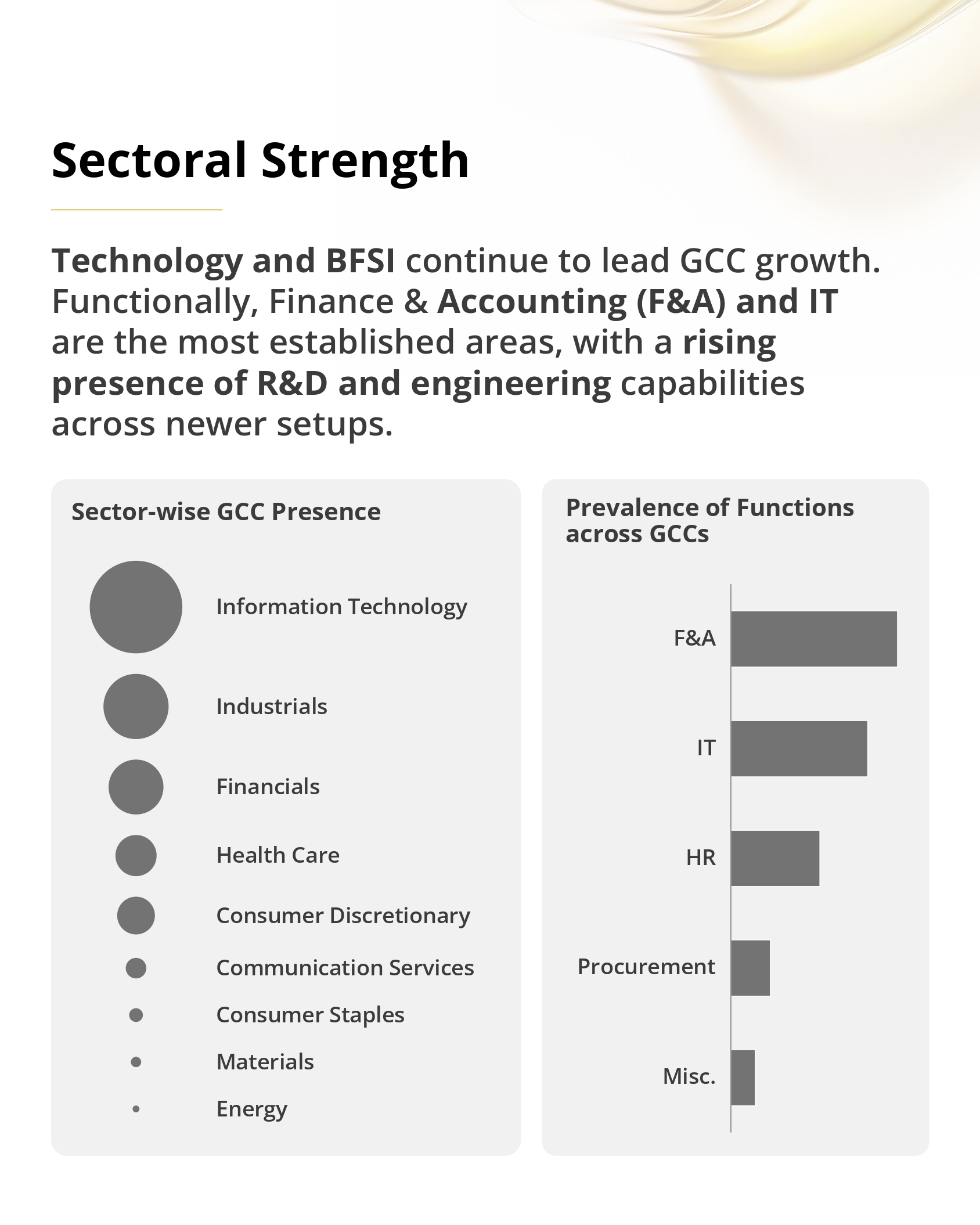
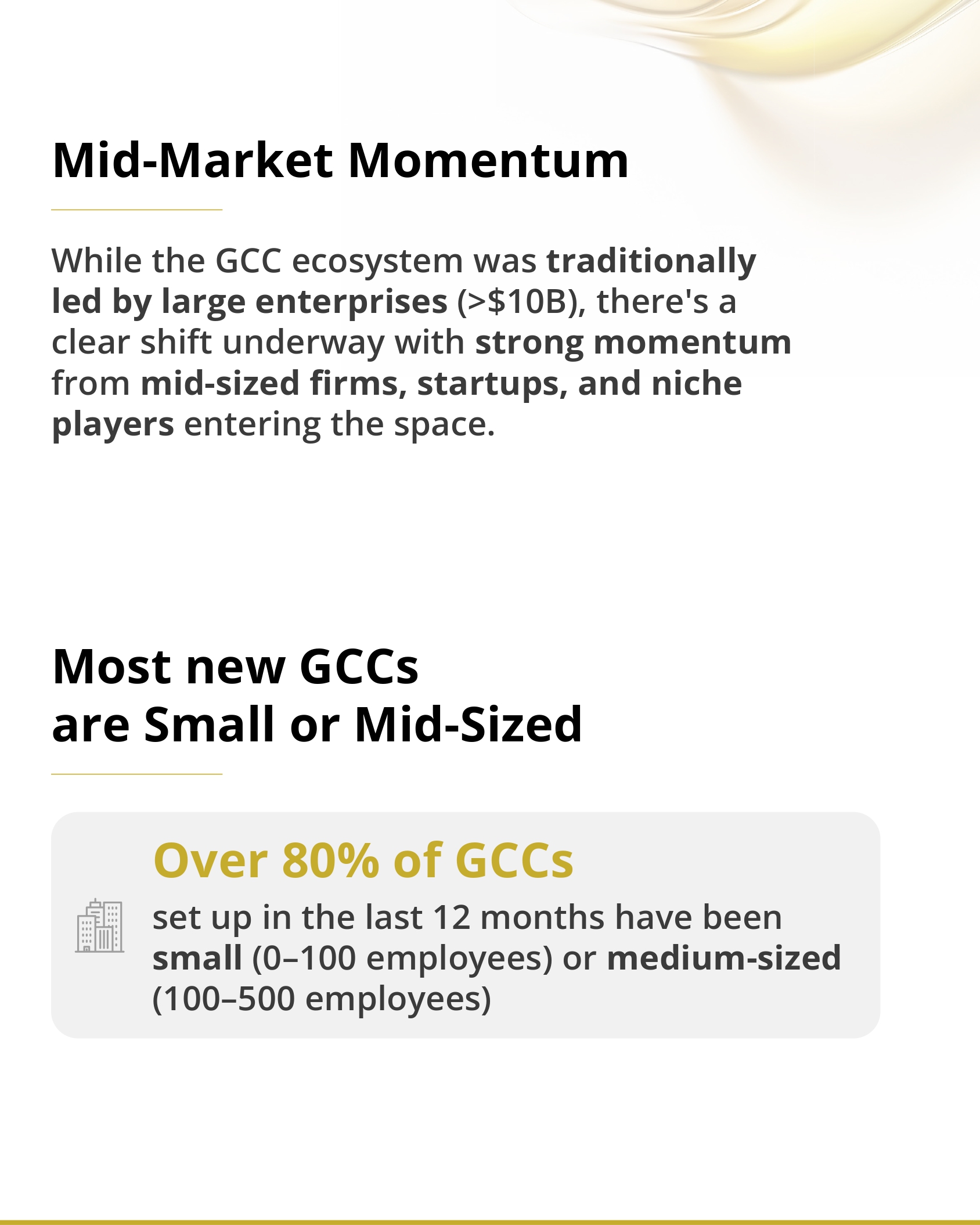

Tier-2 cities, mid-market playmakers, and a surging R&D presence… The GCC map is being redrawn in real-time.
Discover the patterns that matter inside the HEX GCC Database because foresight is strategy.
Let’s explore the possibilities together: https://hexadvisory.com/contact/#mail
Source: LinkedIn

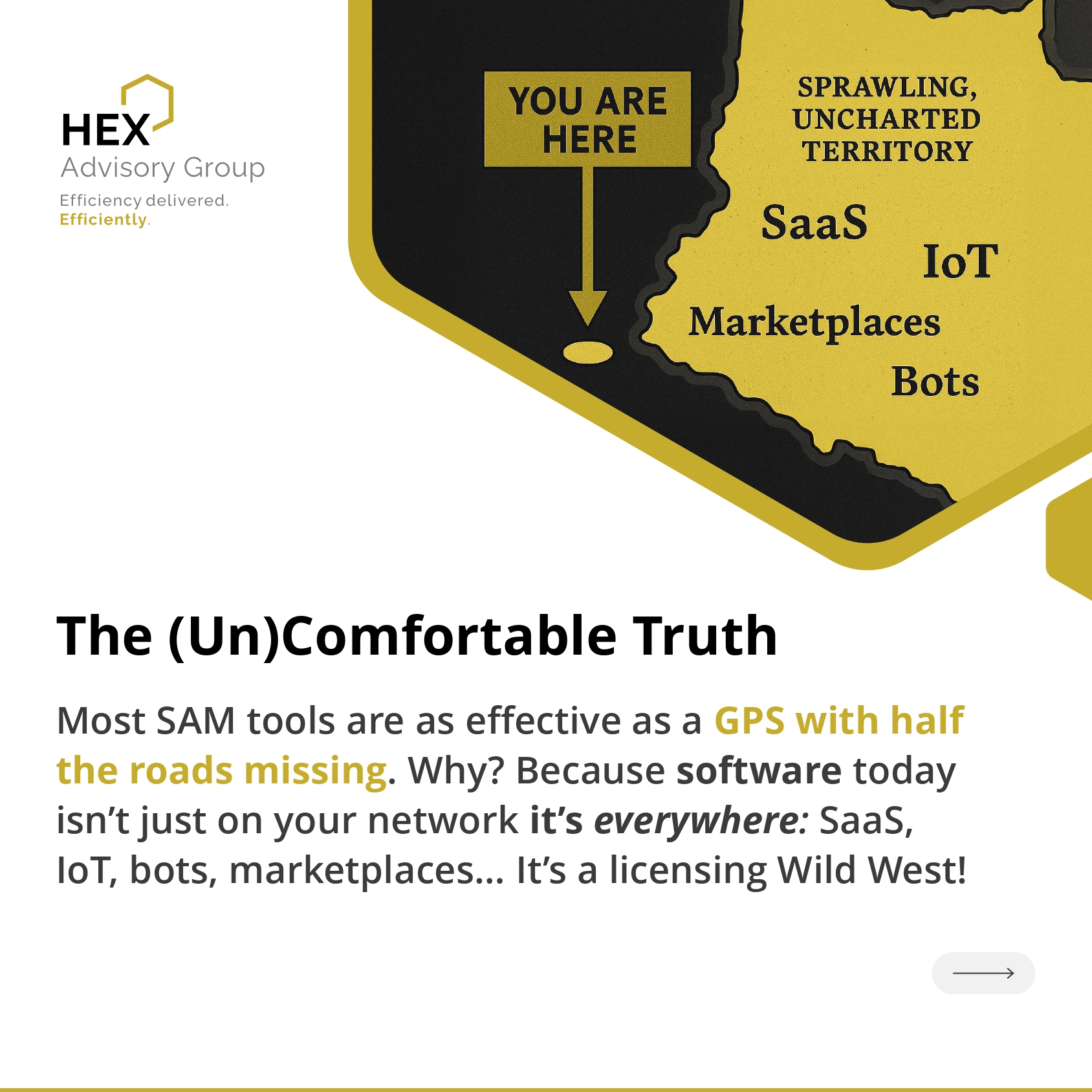
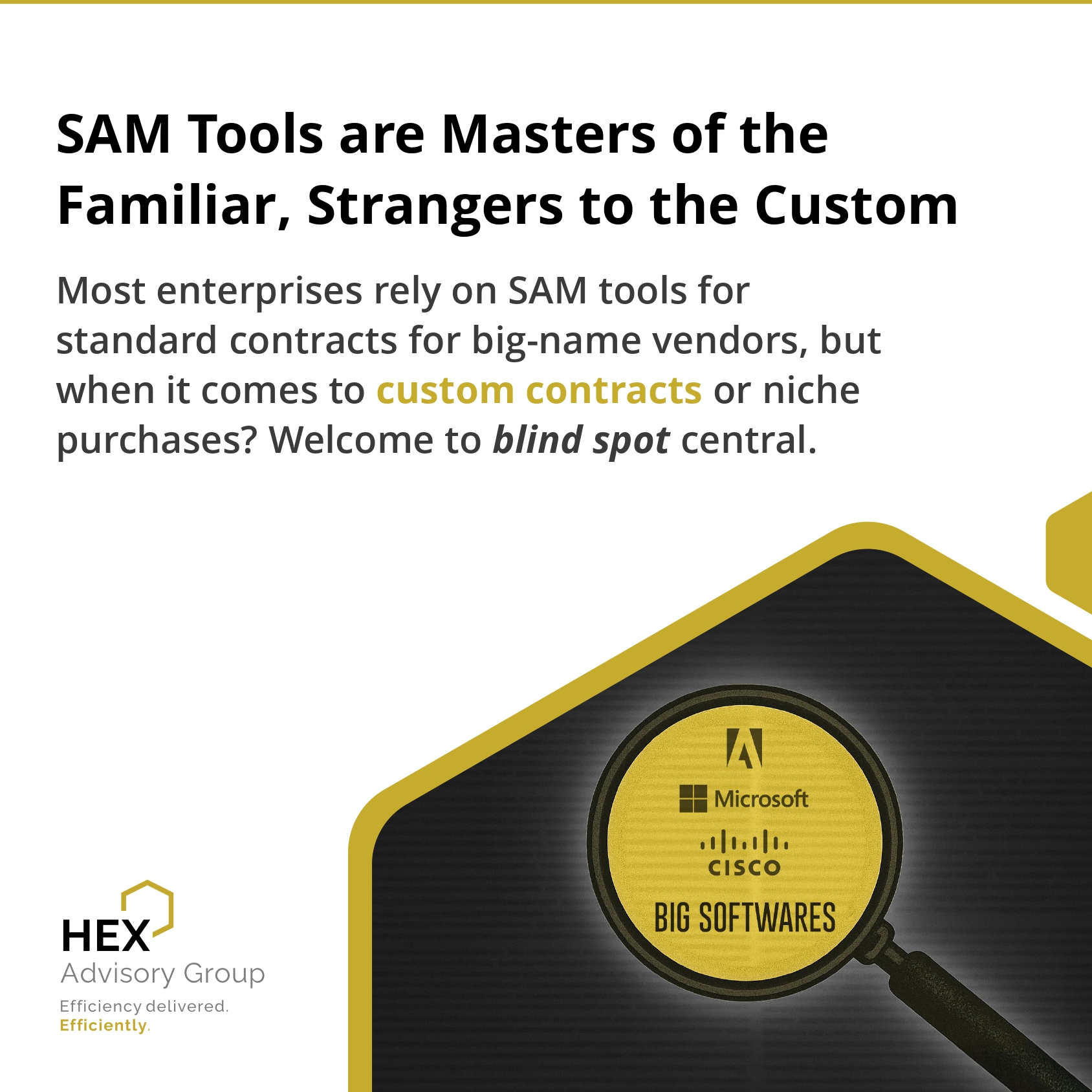

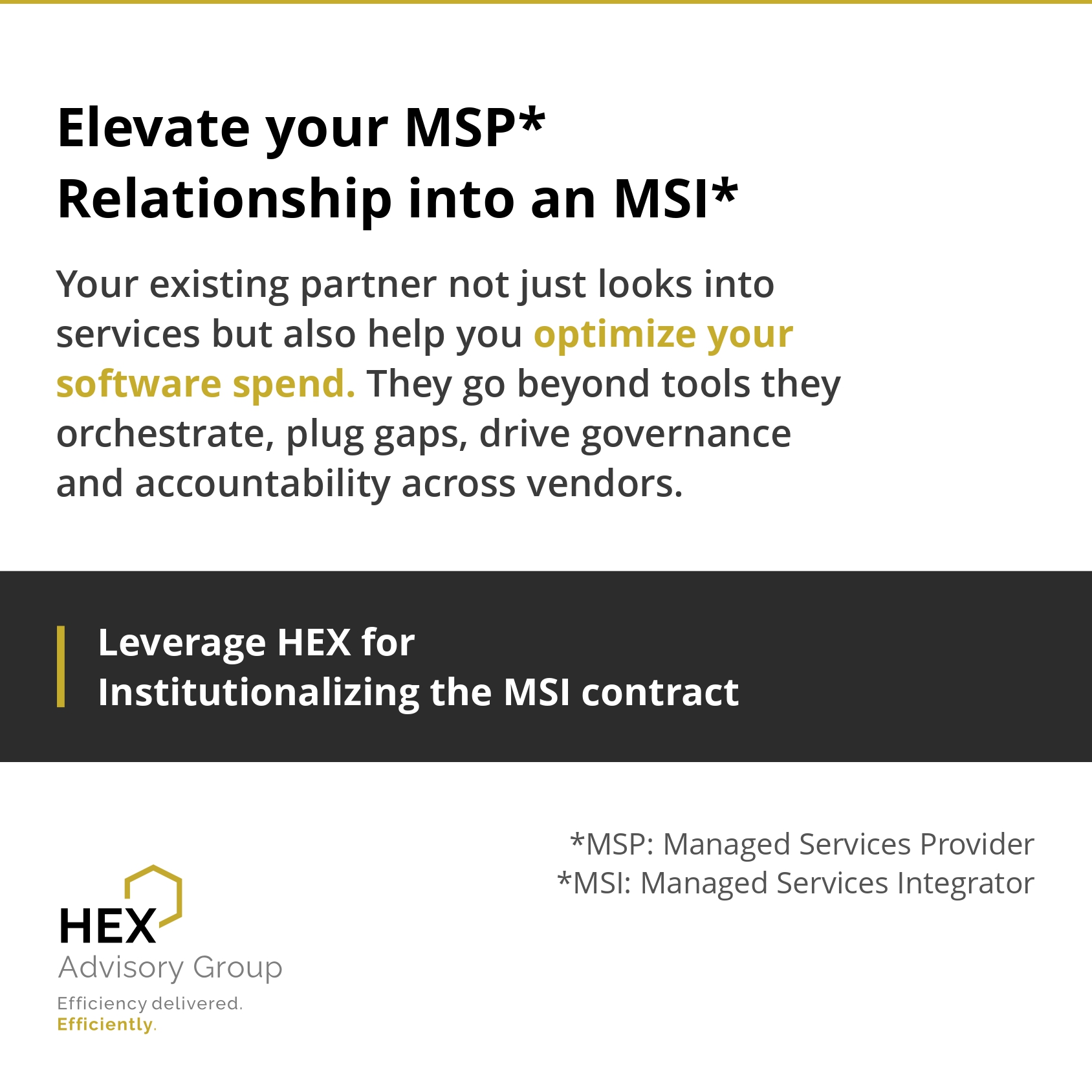
Think your SAM tool covers all the roads? Think again. Time to upgrade your Managed Service Provider into a Managed Service Integrator and master the full map!
Ready to navigate smarter? Let’s talk: https://hexadvisory.com/contact/#mail
Source: LinkedIn
Tired of linear pricing that punishes scale? HEX can help you align your costs with productivity gains, not ticket volume.
The HEX Index is trusted by Fortune 100 client CFO, CIO, VMO and Procurement teams globally to create their sourcing business cases, manage multi-billion dollar IT and BPS spend portfolios, and negotiate contemporary contracts.
Presenting Part 4 of our series “Executive Cheat Sheet on T&Cs”, your no-fluff guide to Contracting 101. We break down dense terms and conditions into what they actually mean, why they matter, and how they impact your IT and BPO deals.
This week’s focus: Benchmarking
Source: LinkedIn
Presenting our Sourcing Disposition Matrix that combines ground-level variables with market intelligence to guide the right placement.
Whether you’re scaling AI platforms or managing a legacy tower, cut through complexity with clarity with HEX:
https://hexadvisory.com/contact/#mail
Source: LinkedIn
BAFO is dead. FAFO is how real decisions get done.
Benchmark first. Bid once. Done right.
Source: LinkedIn
Not all upgrades require a tech overhaul.
Sometimes, it’s just your operating model that’s screaming for attention.
Source: LinkedIn
Unlock Faster Results in GCC Sourcing
Ready to leave the long waits behind? Shift from complexity to clarity, choose a smarter path, streamline your vendor focus, and watch deals get done in record time.
Partner with HEX and let efficiency lead your transformation journey.
Source: LinkedIn
Modern sourcing isn’t about size, it’s about speed, clarity, and control.
HEX delivers all three. Without the drag.
Source: LinkedIn
Which of these moves had you already spotted?
There are more, this list is just the beginning.
Source: LinkedIn
The smartest enterprises are now productizing their capabilities and scaling domain expertise as a service, turning GCCs into Growth Drivers, not just Cost Centers.
Source: LinkedIn
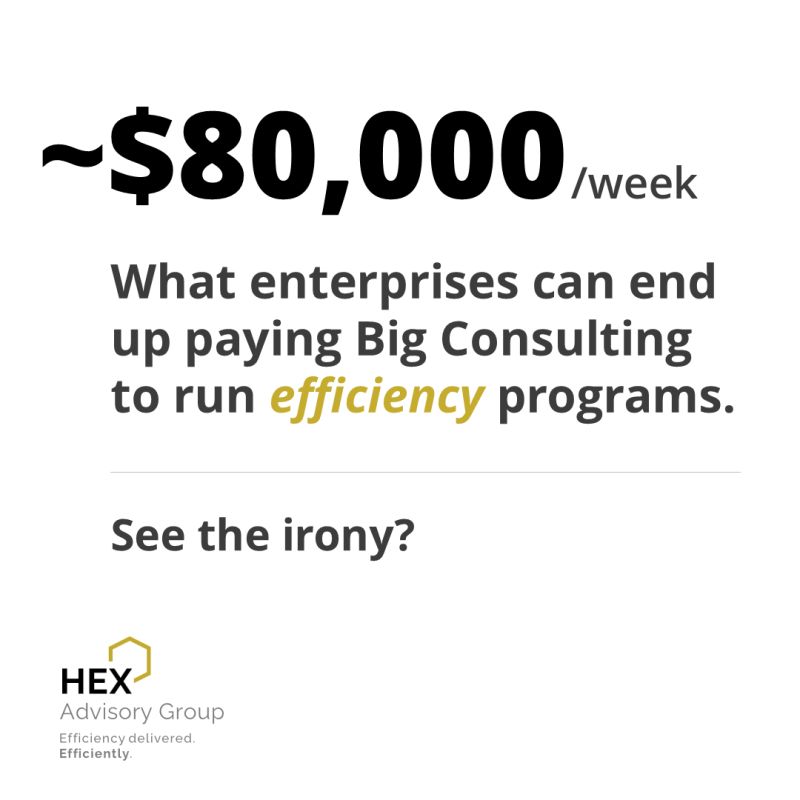
If you’re serious about transformation without the bloated budgets, it’s time to rethink what efficient actually means.
Ready for efficiency delivered… efficiently?
Source: Linkedin
Presenting our Sourcing Disposition Matrix that combines ground-level variables with market intelligence to guide the right placement.
Whether you’re scaling AI platforms or managing a legacy tower, cut through complexity with clarity with HEX: https://hexadvisory.com/contact/#mail
Source: LinkedIn

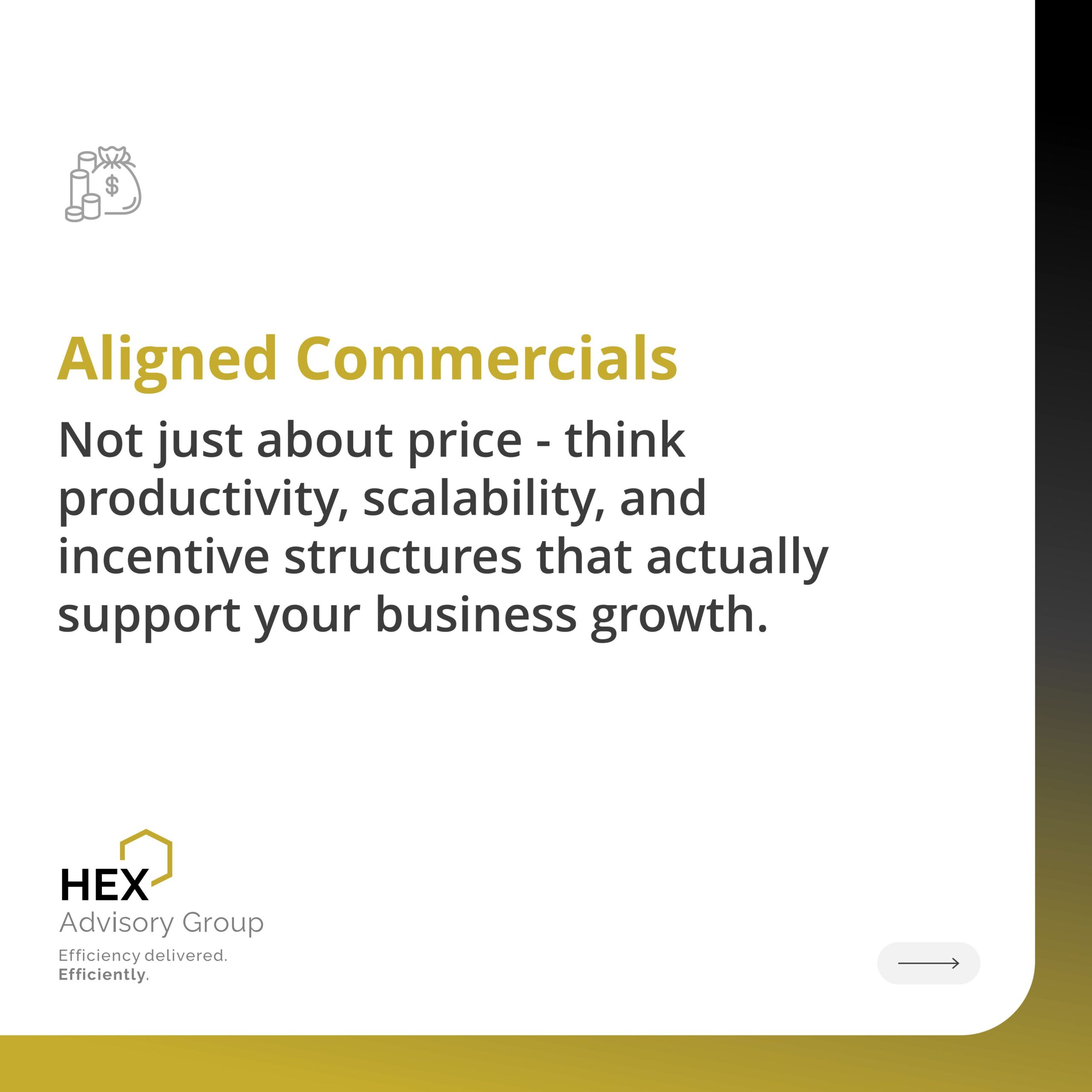
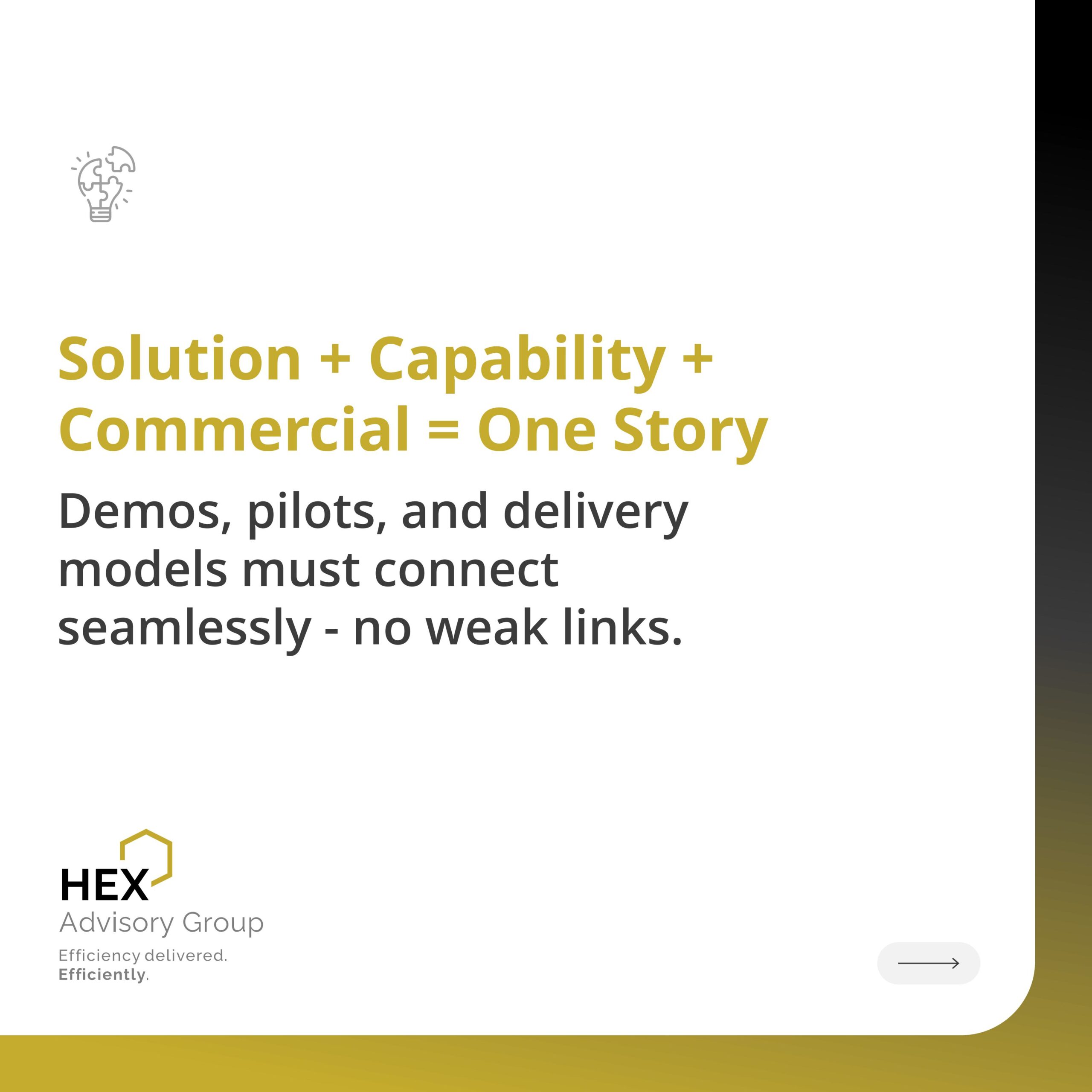
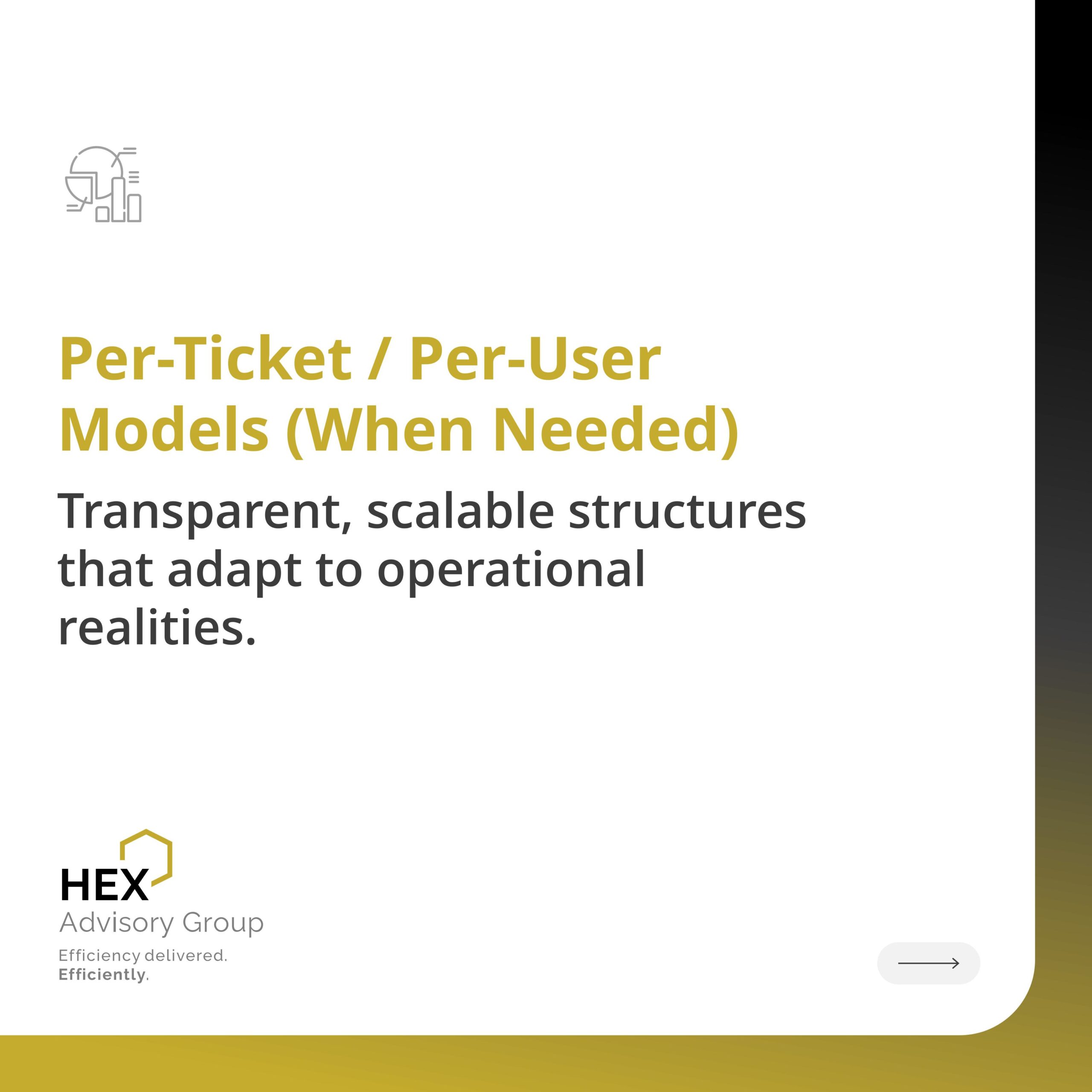
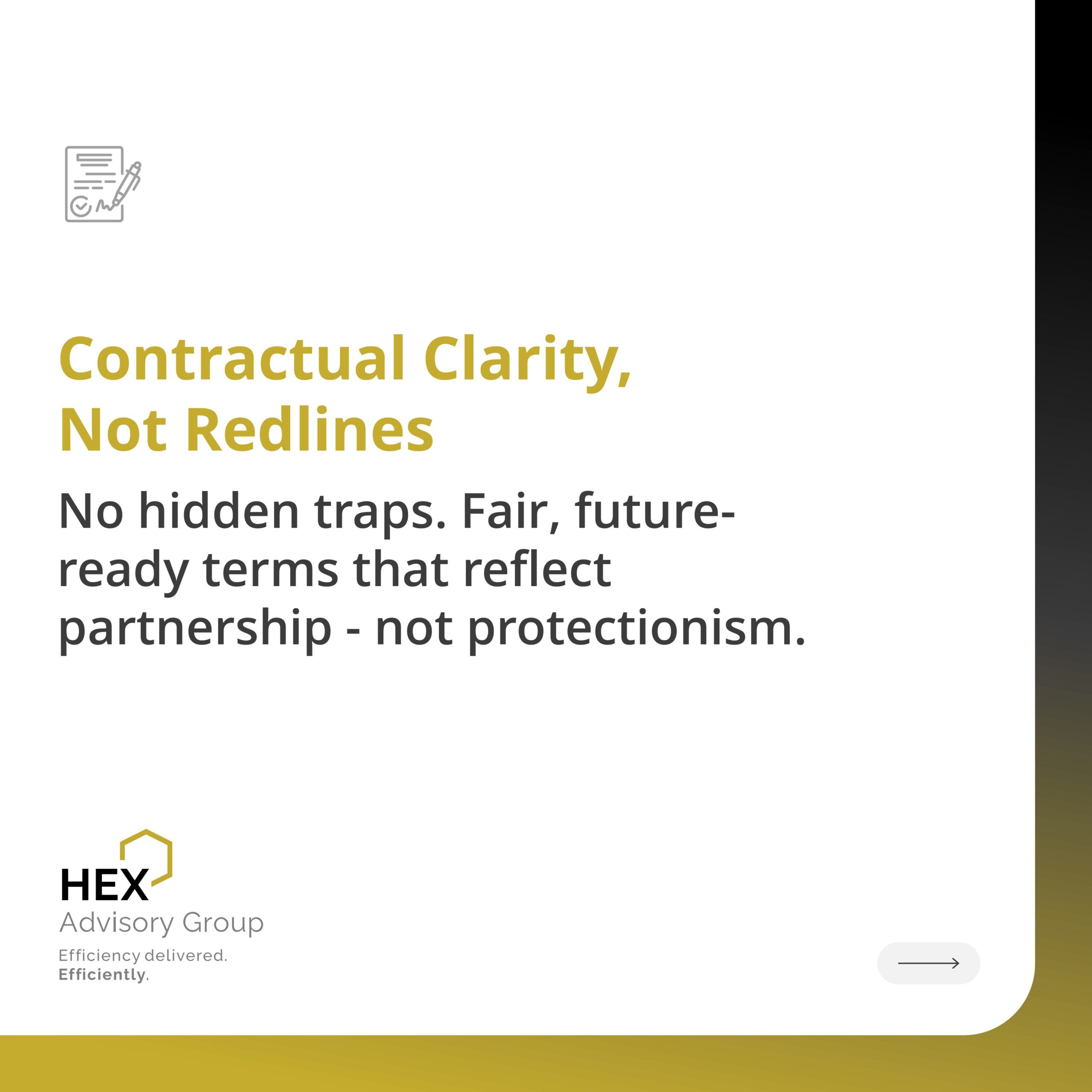


For those who value scalability over scope and clarity over complexity, it’s time to redefine what a true value partner means in your sourcing strategy.
No redlines, no fluff. Just outcomes that align with your growth.
Source: LinkedIn
Still waiting 16 weeks for an RFP cycle to finish?
There’s a smarter, faster way.
At HEX Advisory Group, we don’t run vendor races just to “pick ponies and make monies.”
We’re redefining the RFP process with real benchmarks across solution fit, pricing, performance, and contractual clarity so leaders like you make the right call the first time.
⚡ Done in 4 weeks, not 16
Vendor-agnostic, data-driven decisions
Trusted by top IT and procurement leaders
You don’t have to gamble on guesswork.
Get results — efficiently.
Source: LinkedIn
Some things do look great when inflated — like this golden balloon.
But your advisory billables? That’s where HEX draws the line.
Let’s deflate the drama and your costs.
Source: LinkedIn
The Joint Venture GCC model: because CXOs don’t have time for trial-and-error. What if your next GCC came with control, speed, and certainty baked in?
Source: LinkedIn
The Tredence Inc. Analyst Day proved one thing: Agentic AI is not coming—it’s already here and HEX saw it live: The agency revolution.
Source: LinkedIn
Gen AI is the buzz. Agentic AI is the business. One writes, the other acts. Which one is powering your enterprise?
HEX simplifies this difference through this CXO Cheat sheet.4
Source: LinkedIn
GCCs are heating up and Service Integration providers are switching the tempo.
No-more change the face paint to BOT and perpetuate play. Instead SI C-suite are investing in dedicated GCC leadership, specialized M&As, account-based GCC farming, and augmentative solutions.
Source: LinkedIn
If your scale plan includes 10 new languages and 100 new hires—start over.
There’s a smarter way to do global that too, at scale.
Source: LinkedIn

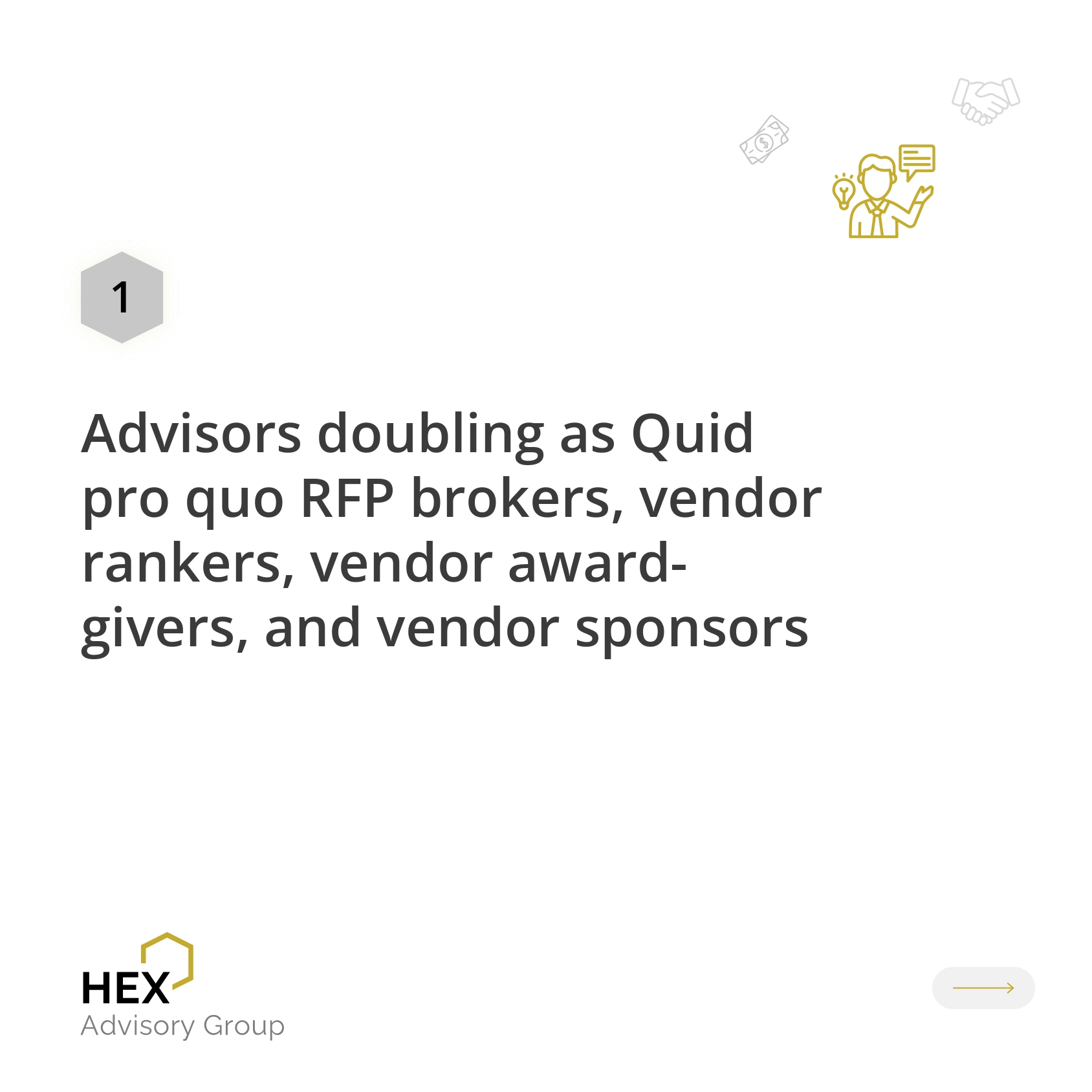
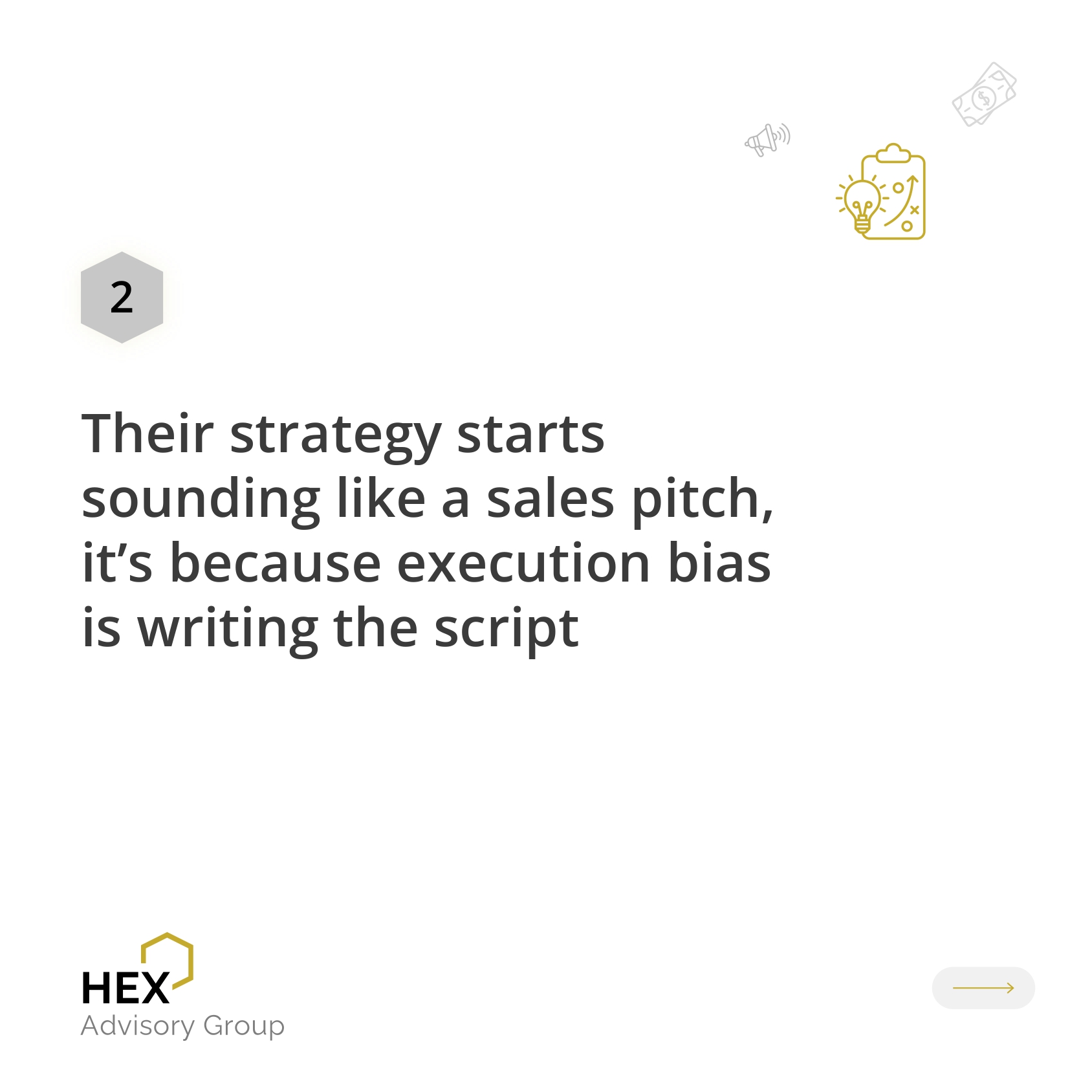
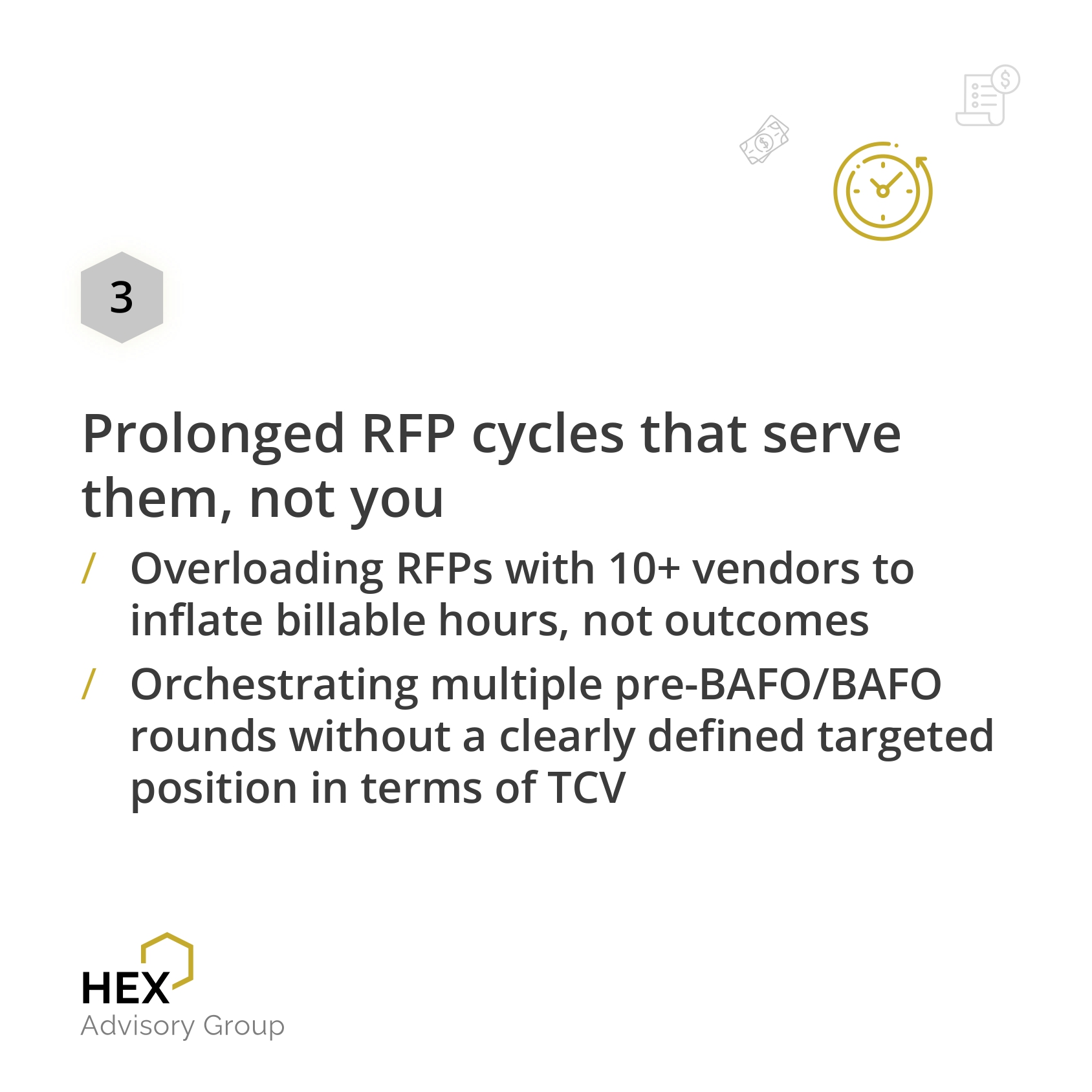

Is your “independent” advisor a pay-to-play conduit? – siphoning money from hopeful vendors while working on your enterprise dime?
It’s necessary to check for hidden strings when you choose an advisor.
Source: LinkedIn
Cognitive automation isn’t the future, It’s the now (thanks to AI)
If your workflows still wait for instructions, they’re already obsolete.
Source: LinkedIn
Sole-sourced deals don’t have to bleed value.
Vendors may price with impunity, but with the right benchmarks and negotiation expertise, you can secure competitive terms, faster turnaround, and significant savings.
Here’s how HEX helped one of the world’s largest hospitality chains achieve market-aligned pricing, equitable terms, and expedited results.
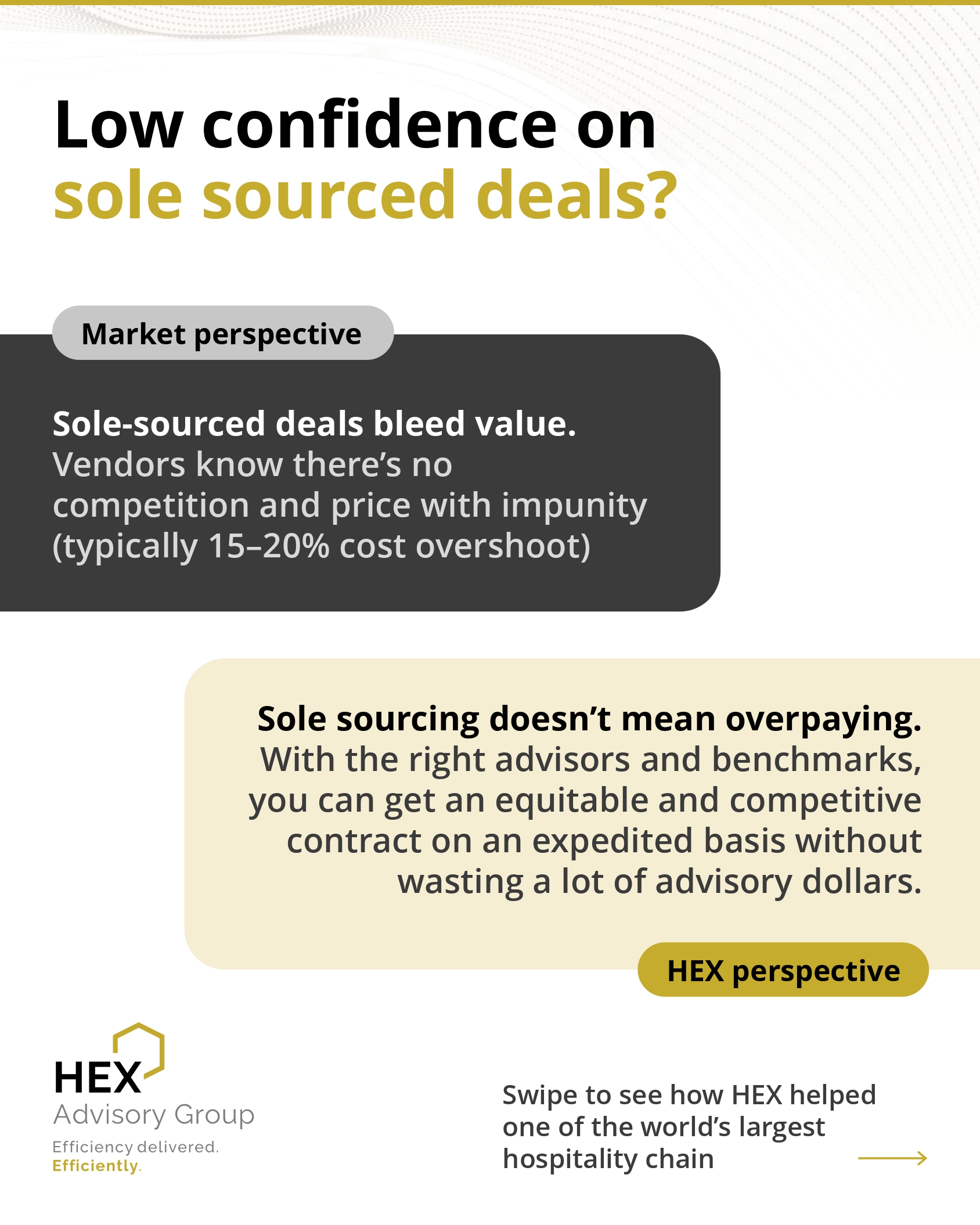
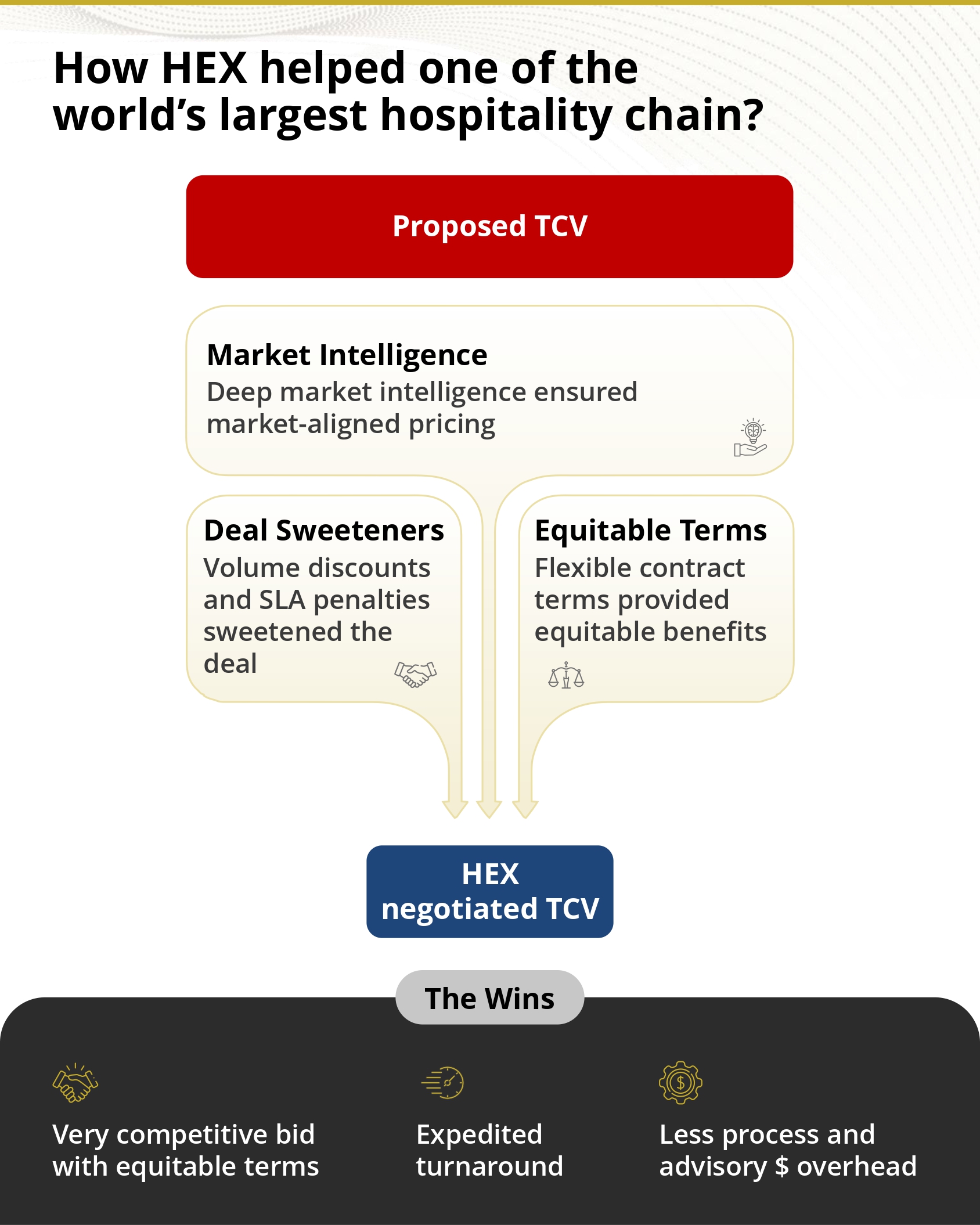
Presenting Part 3 of our series — “Executive Cheat Sheet on T&Cs” — your no-fluff guide to Contracting 101. We break down dense terms and conditions into what they actually mean, why they matter, and how they impact your IT and BPO deals.
This week’s focus: Step-In Rights

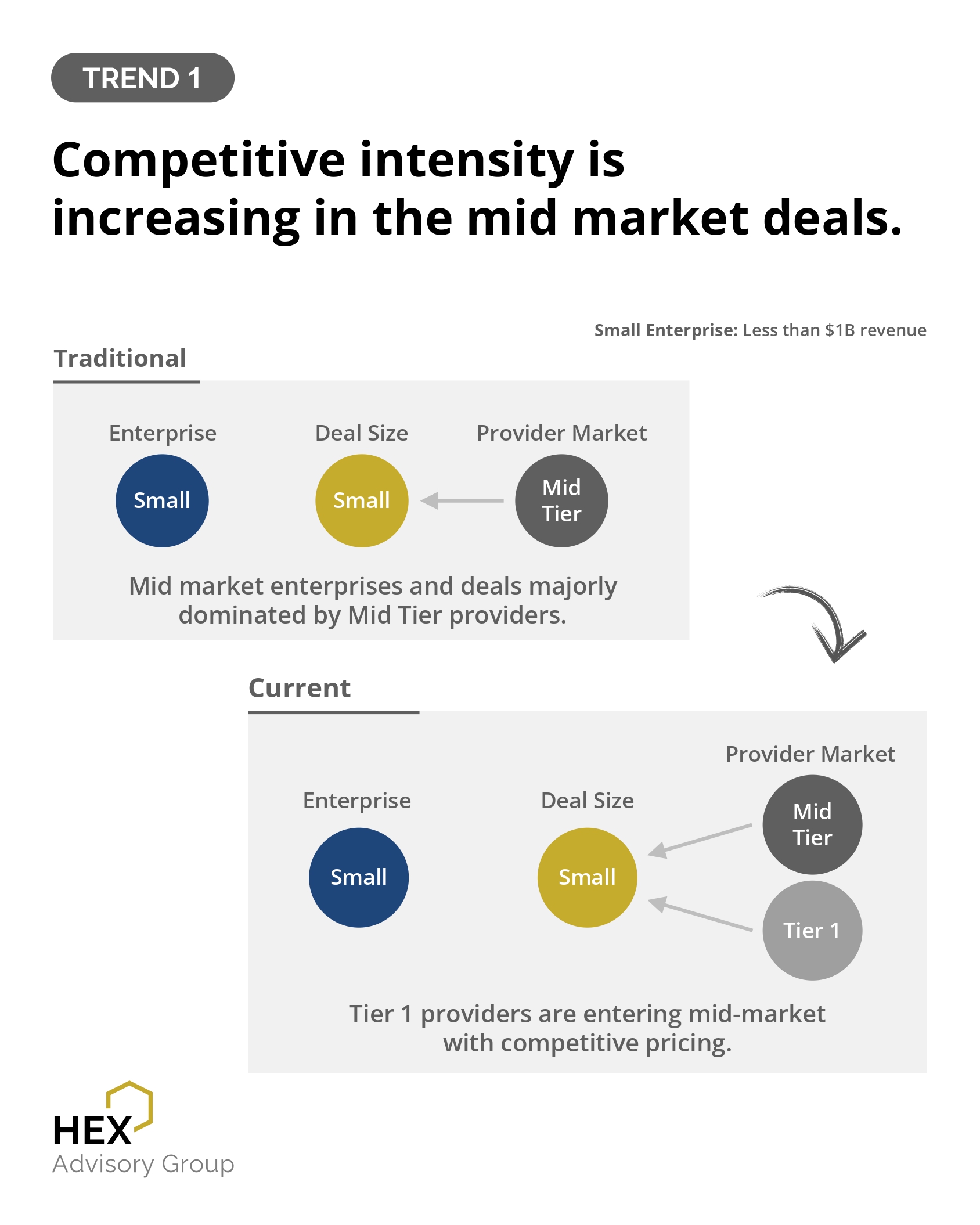


Recent trends are redrawing the battle lines in Mid Market Deals.
Bridge the gap with insights that anticipate the shift. Stay ahead or risk falling behind.
When your advisor recommends a vendor circus, it’s not strategy, it’s showbiz (and billable hours). At HEX, we cut through the noise.

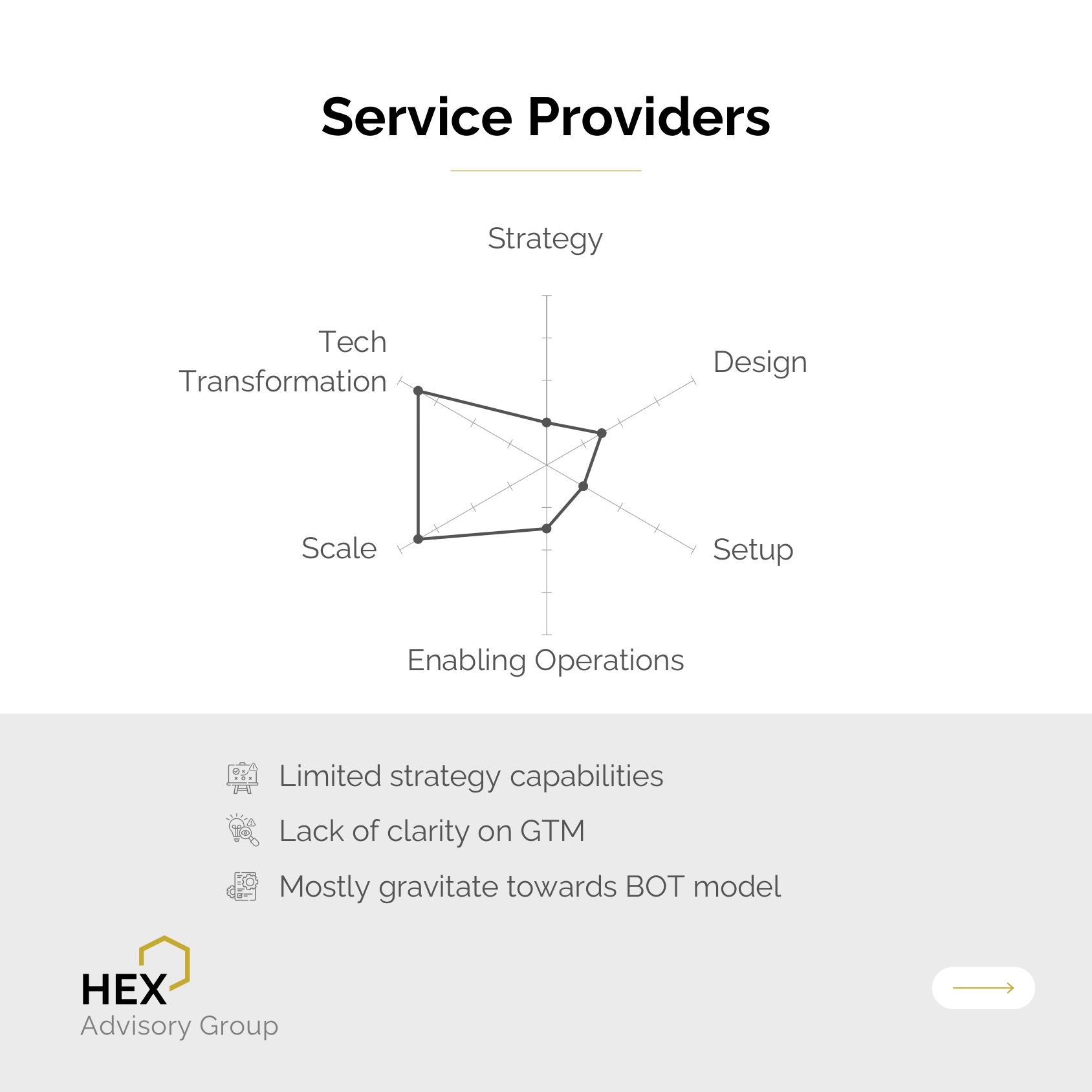
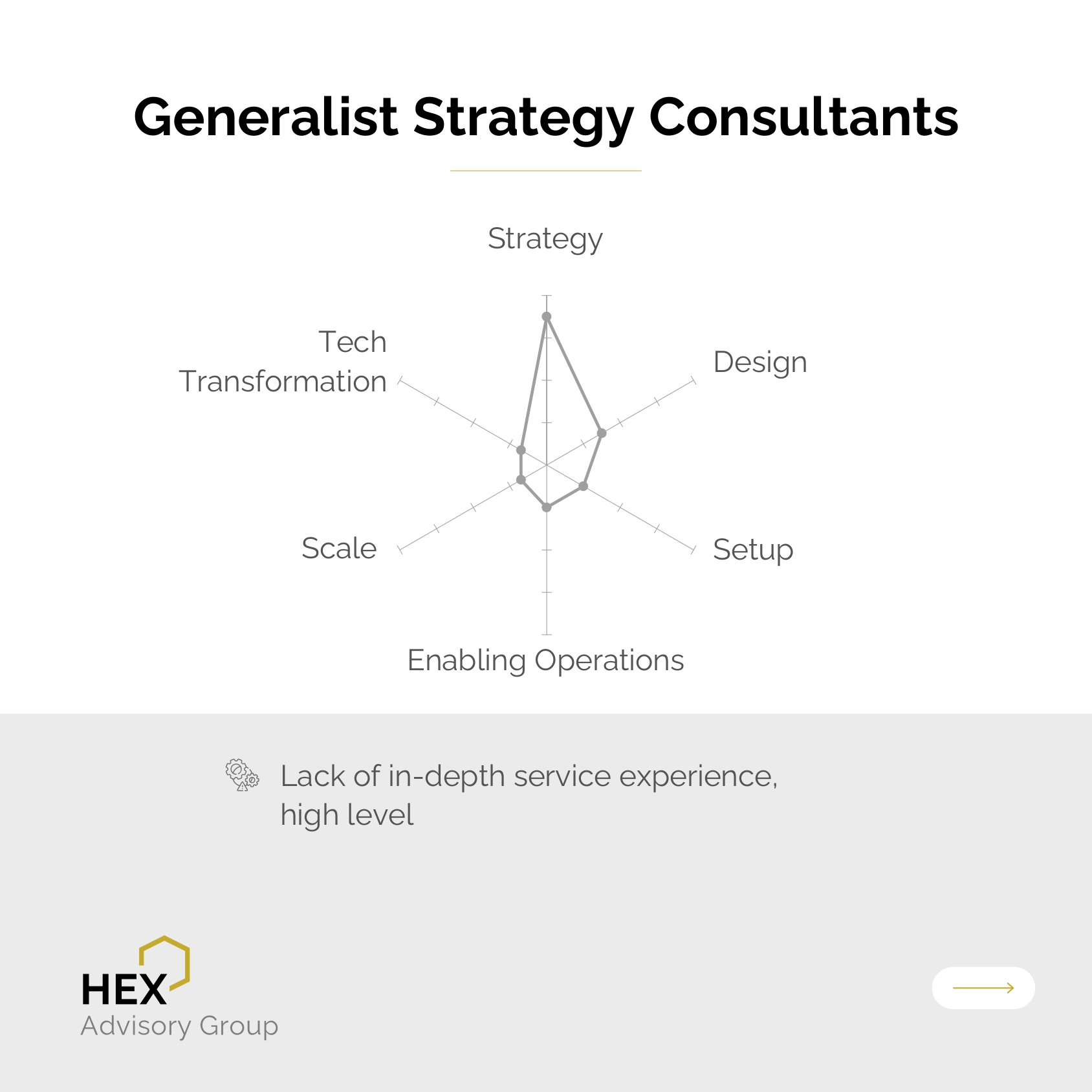
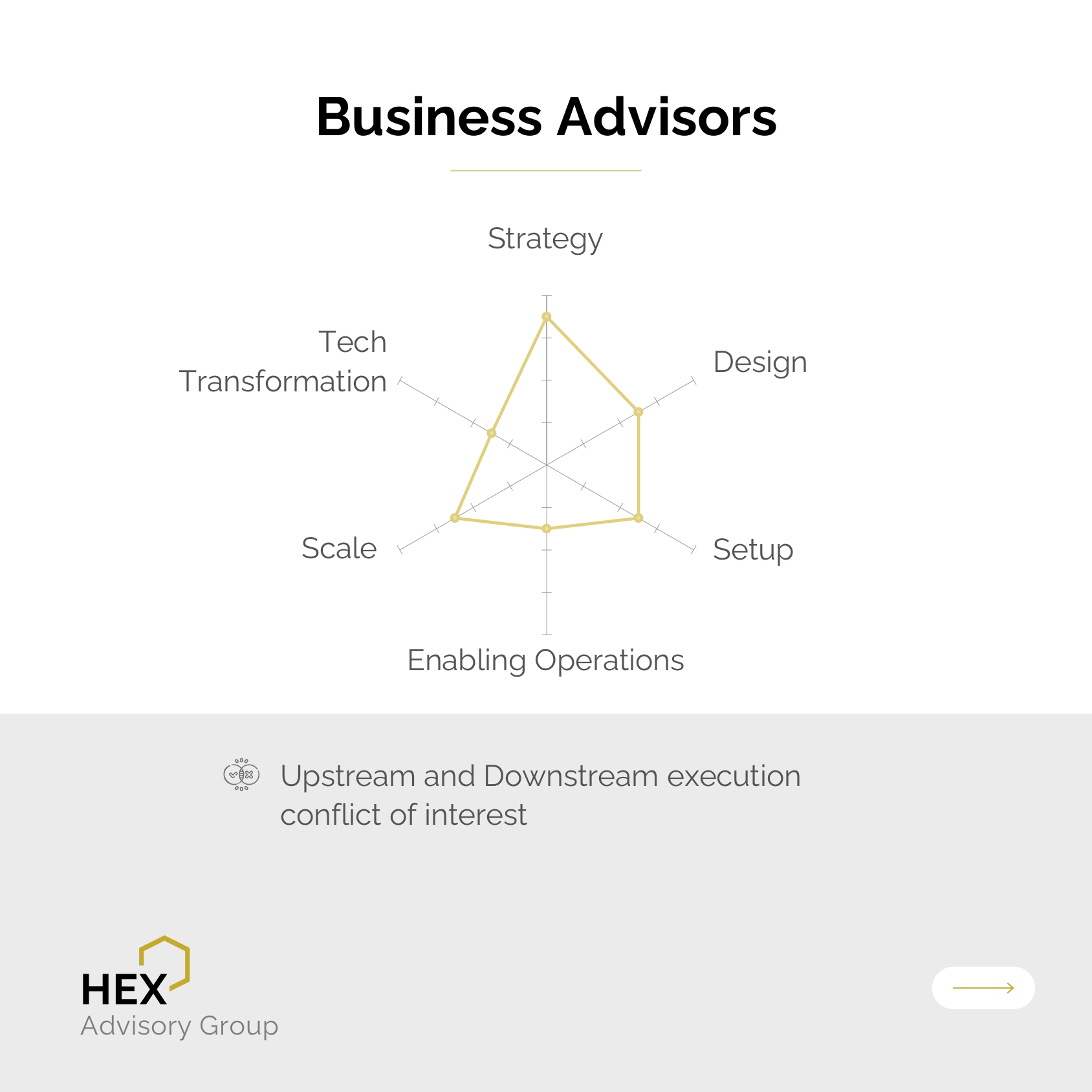
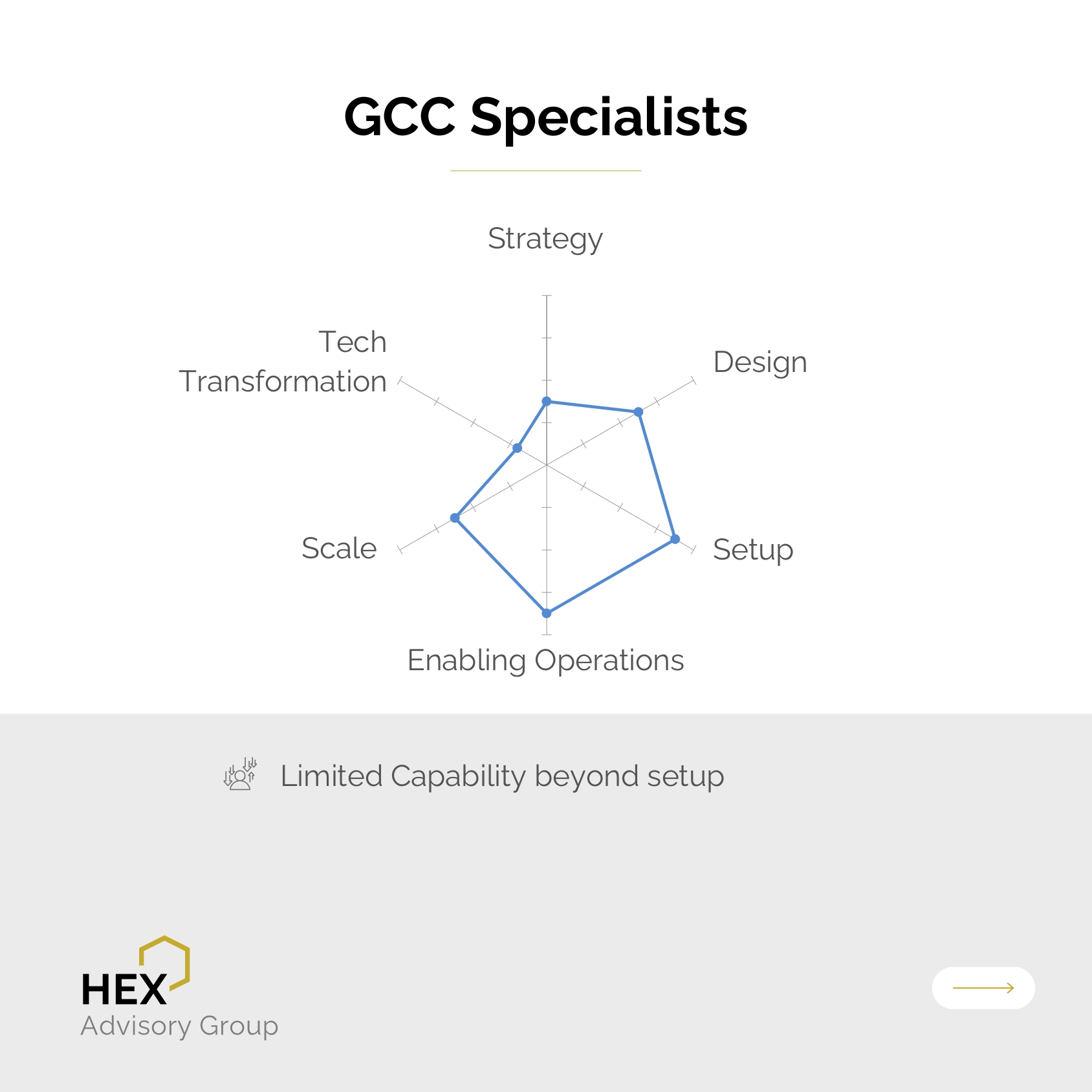
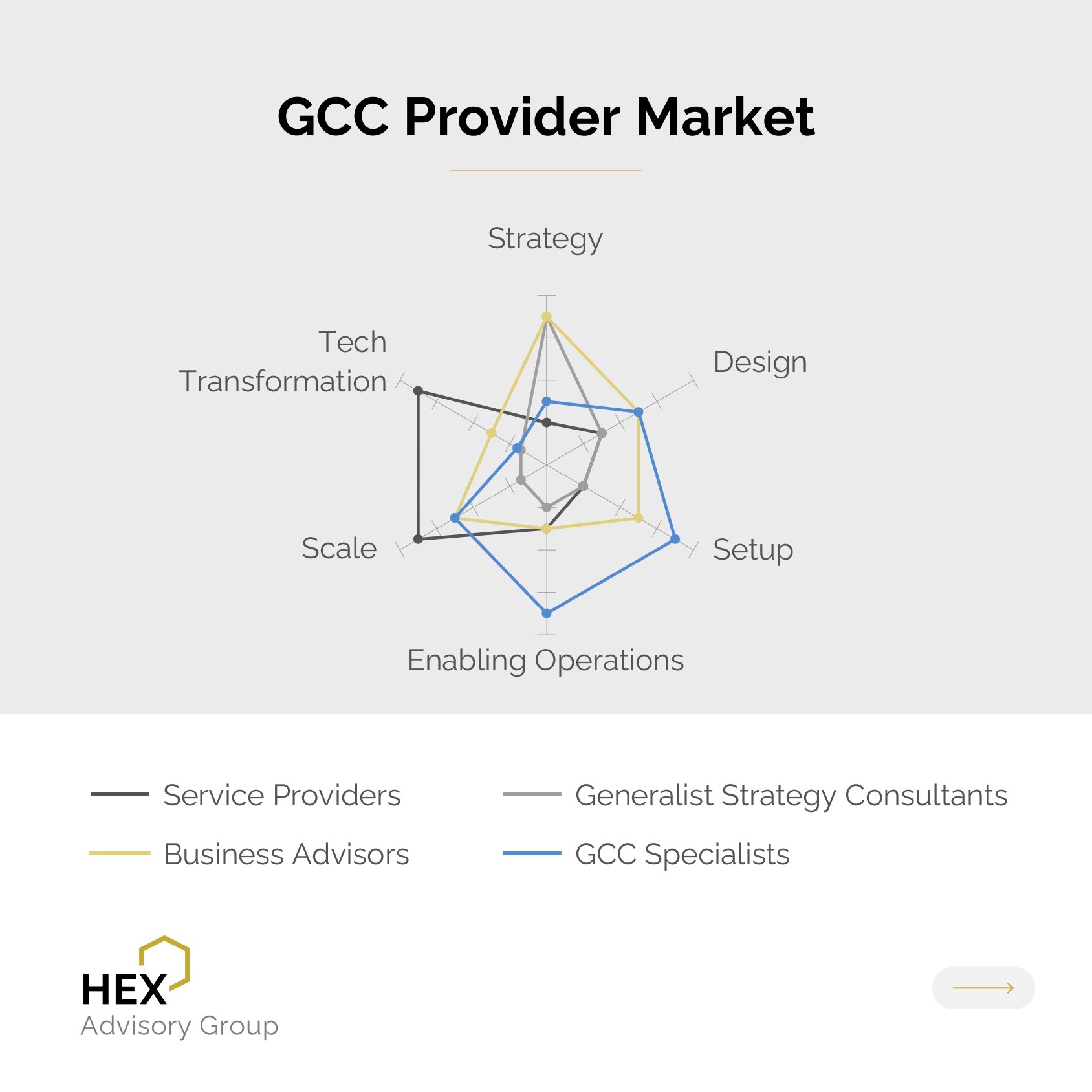

This breakdown of GCC providers helps you assess who truly delivers across key dimensions like setup, strategy, and operations.
Are you evaluating your GCC provider with the right lens? Let’s discuss.
Let’s talk: https://hexadvisory.com/contact/#mail
HEX has won every solution-centric enterprise conversation against big consulting this year—across Large Cap, Mid Cap, and PEPortcos.
Like us, our Sourcing solutions are radically commonsensical, outrageously fast, and implausibly tangible. We don’t chase logos—we build peer advocacy.
Still running on hold music and manual tickets?
It’s time to replace phone queues with bots, AI, and self-heal.
Want to modernize your service desk?
Let’s talk: https://hexadvisory.com/contact/#mail
GCCs in Tier 2/3 cities aren’t the next big thing — they’re already in play. Your GCC doesn’t have to follow the Tier 1 crowd, it can lead the shift.
HEX can show you where:
HEX Index isn’t just another benchmarking tool in the IT and BPO sourcing space. It’s the only one where data integrity meets execution credibility.
Why does that matter?
Because the very advisors delivering enterprise sourcing outcomes like Sarthak Brahma—are the same experts behind the benchmarks.
This isn’t third-party hearsay. It’s firsthand, referenceable insight from real CXO engagements.
That level of clarity? Unmatched in the industry.
The REAL McCoy of Benchmarking.
REAL Transactions Data curated by REAL Sourcing Practitioners.
Connect with HEX Advisory Group’s Think Tank – Sourcing, Shoring, and Benchmarking practitioners in the – : https://hexadvisory.com/contact/#mail
What does control, cost, and compliance look like under different staffing models? This at-a-glance breakdown by HEX gives enterprise leaders a clear view on whether MSP or Staff Augmentation is the smarter choice for their goals.
Hint: It’s not one-size-fits-all.
Generic business cases got you budgeting blind?
HEX cuts the fluff with real-world data, real results, and minimal deviation.
30%+ variance? Not on our watch!
Here’s a sneak peek into Life at HEX — a year of big wins, bold moves, and a bit of boogie
Work hard, party harder… and then do it all over again.
The long-drawn RFP-to-contract process is an old hack.
Today’s Fortune 500s are rethinking IT sourcing with agile models like GCCs, sole-sourced bids, among others enabling faster, leaner, and more strategic decisions.
It’s not just about savings—it’s about speed, control, and long-term value creation.
Explore how new-age sourcing models are reshaping the enterprise IT playbook: https://hexadvisory.com/contact/#mail




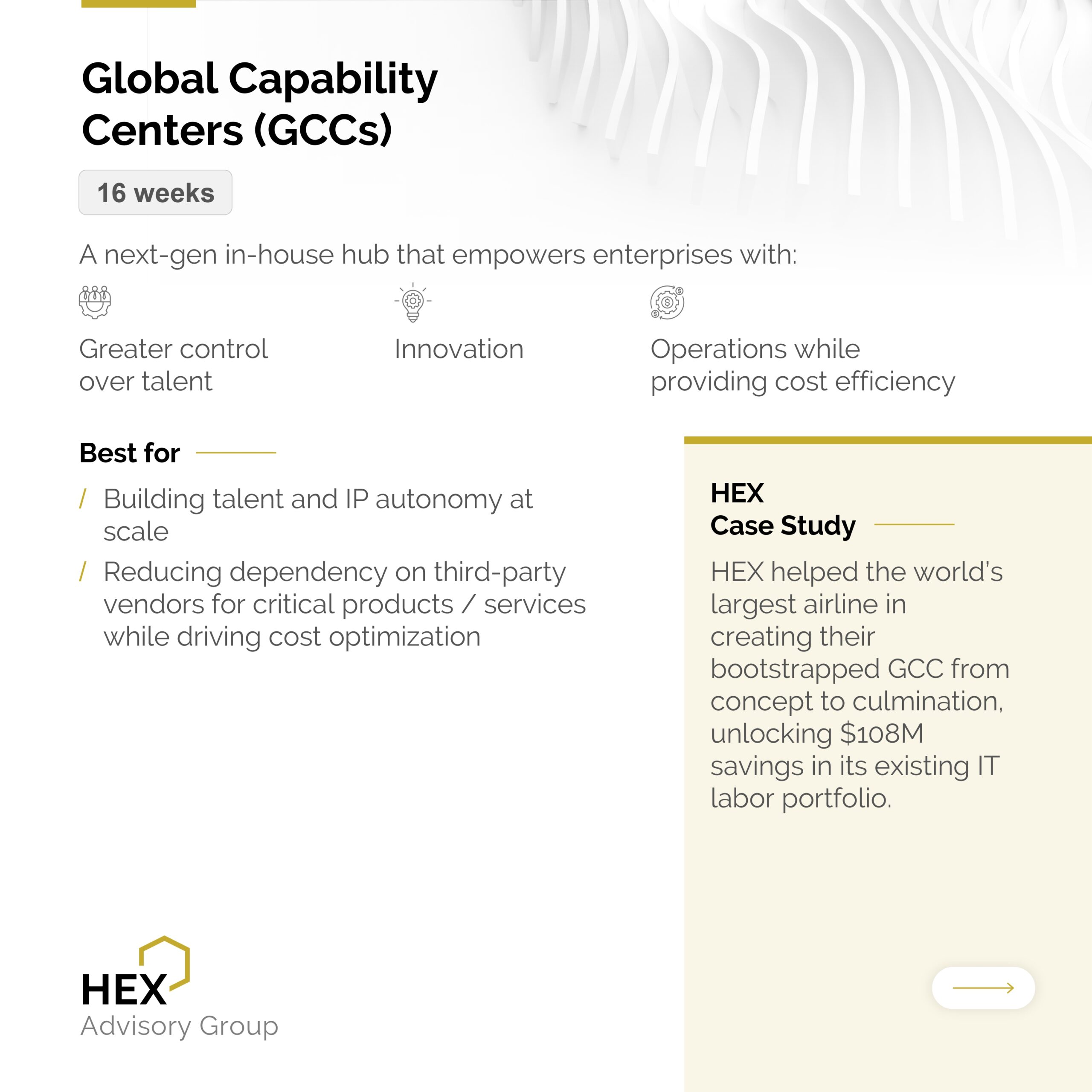

HEX presents the “Executive Cheat Sheet on T&Cs” — your no-fluff guide to Contracting 101. We break down those dense terms & conditions into what they actually mean, why they matter, and how they impact your IT BPO deals.
With Trump’s latest tariff bombshell, the global market is recalibrating. HEX unpacks key nuances—from trade imbalances to real-world business shifts.
Will these tariffs reshape global IT outsourcing? Drop your thoughts below!
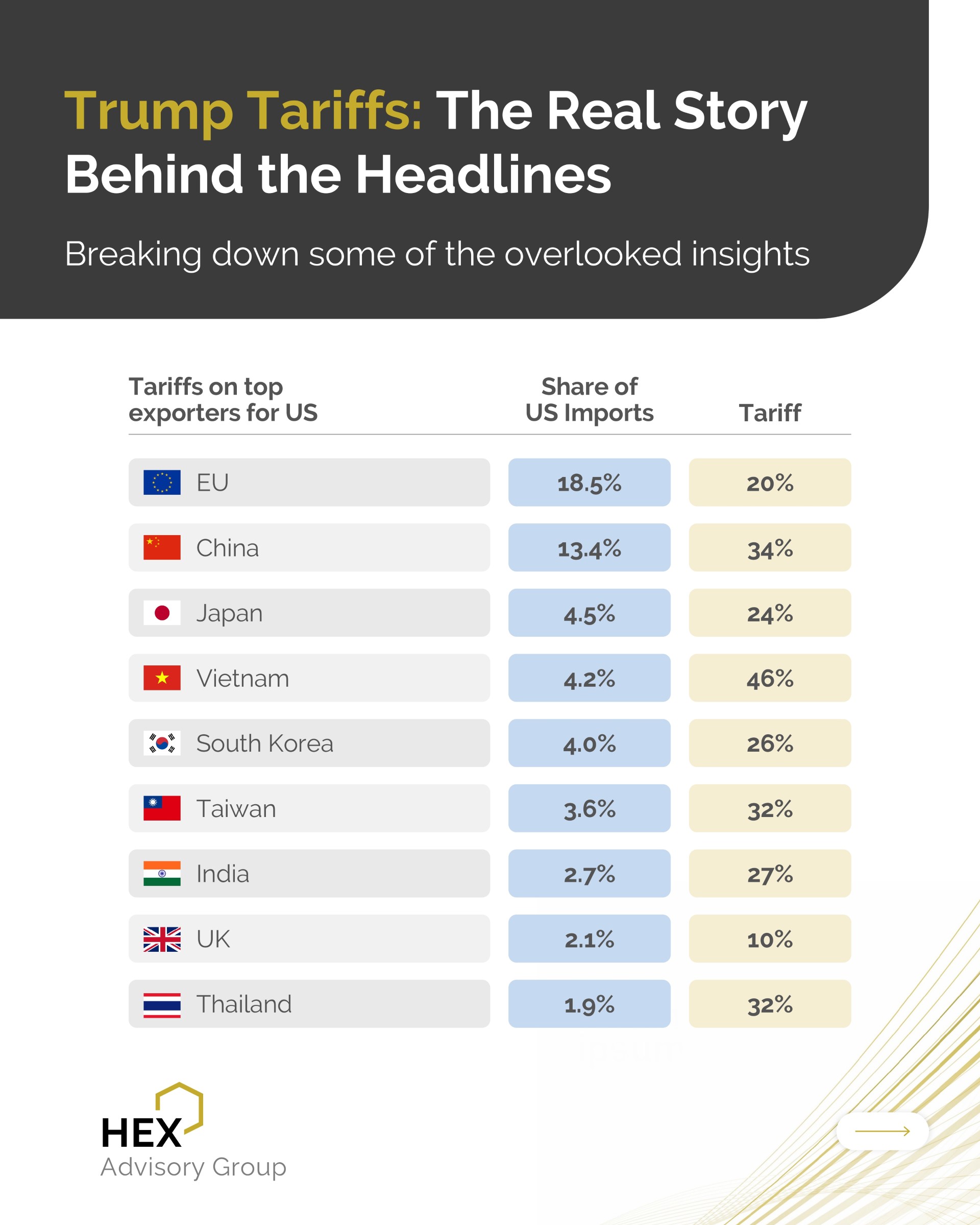
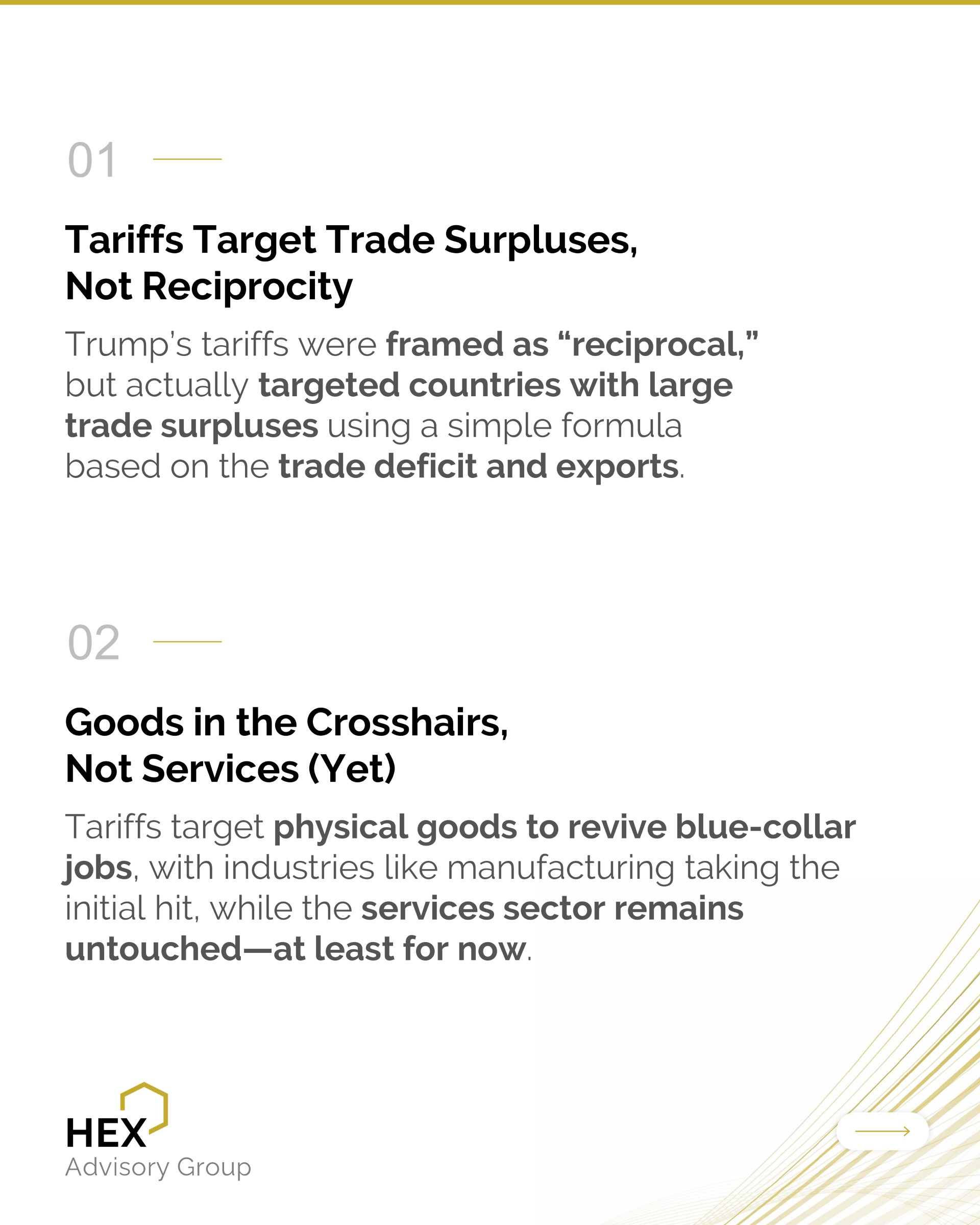
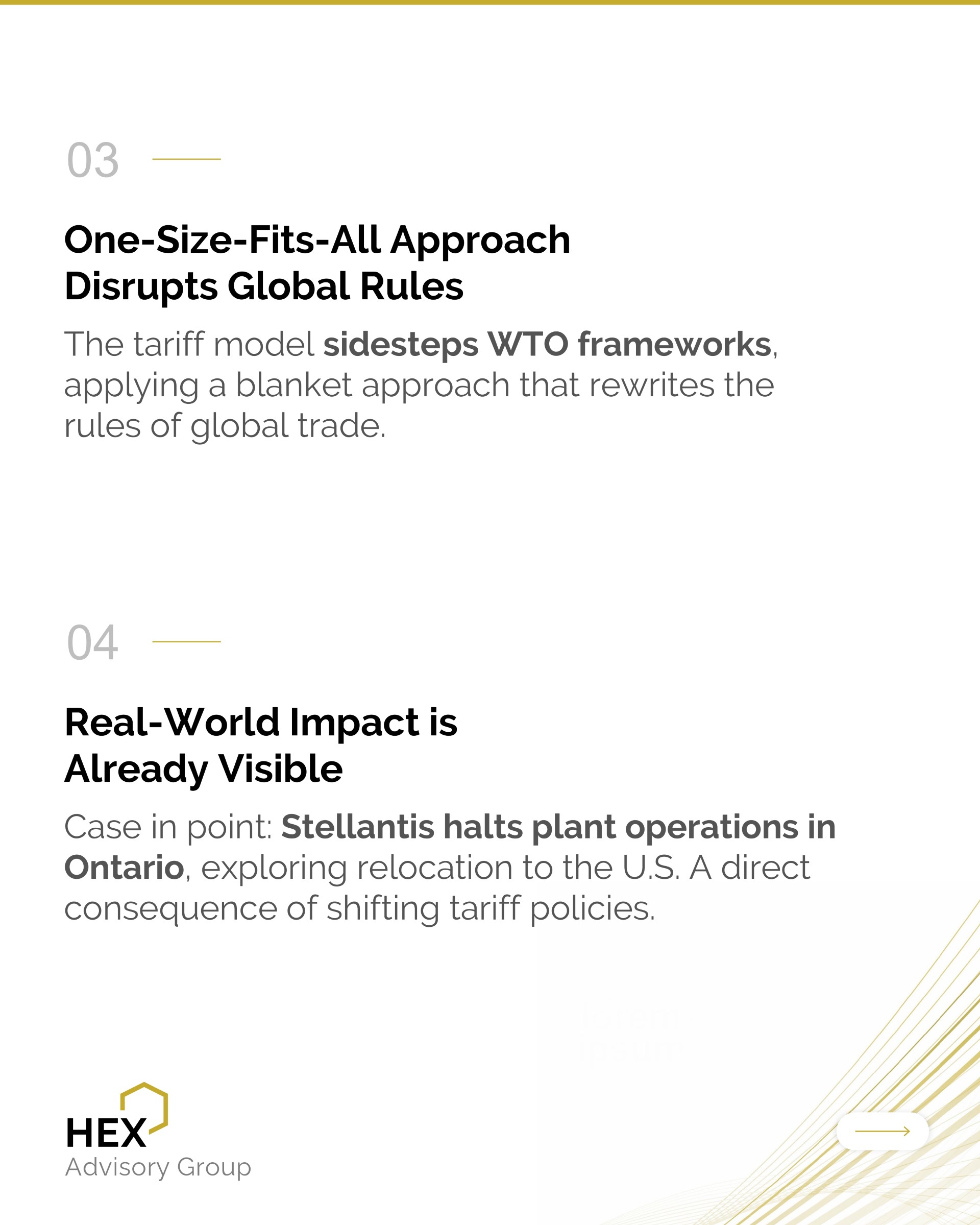
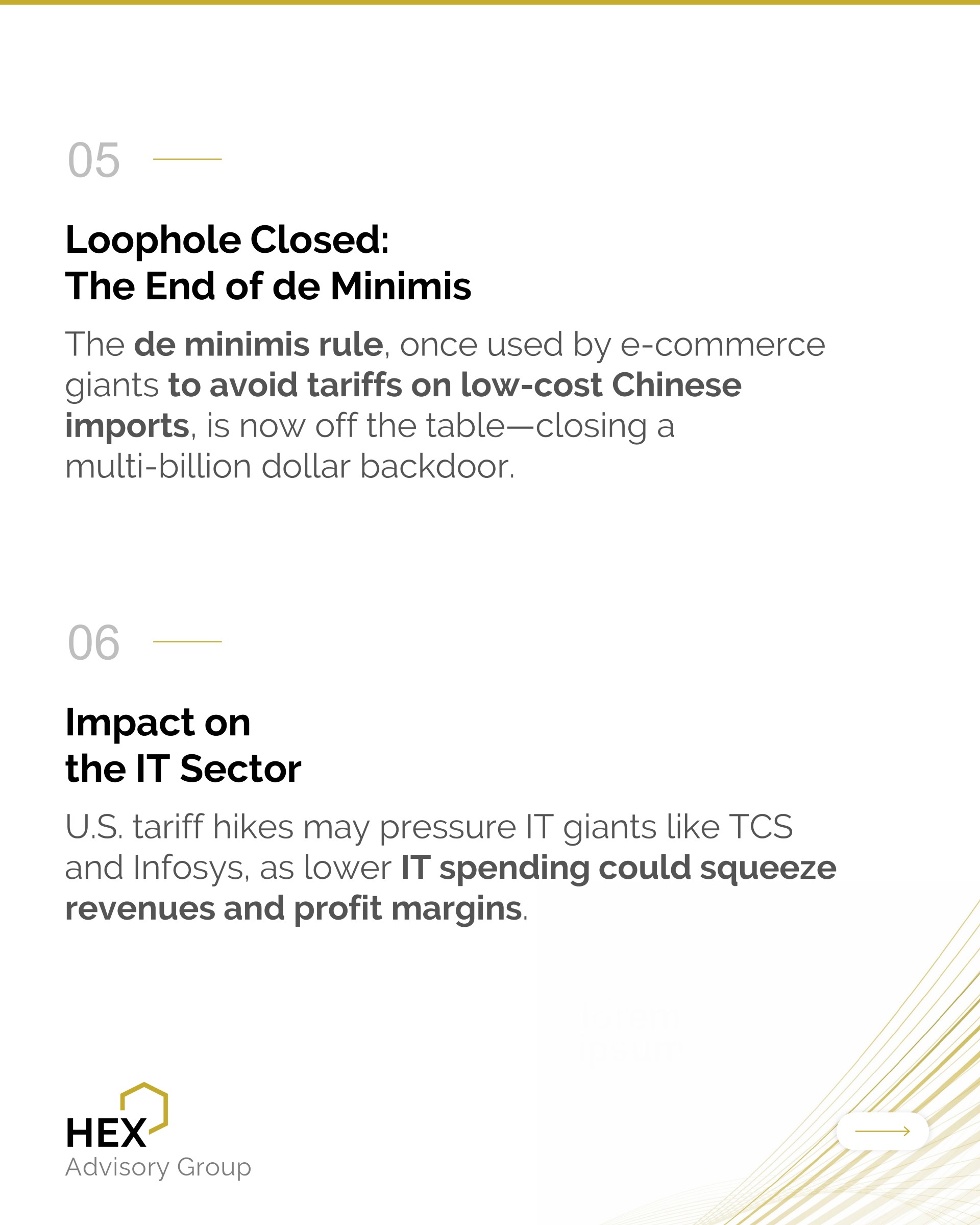

HEX Advisory Group is championing awareness and impact for marginalized sports and initiatives in India as part of its CSR undertaking. Proud to support the National Tenni-Koit Championships in Odisha —where tradition meets opportunity!
Tariff-induced shifts in global dynamics are shaking up the IT outsourcing industry. Explore the key trends enterprises must know to stay competitive and resilient.


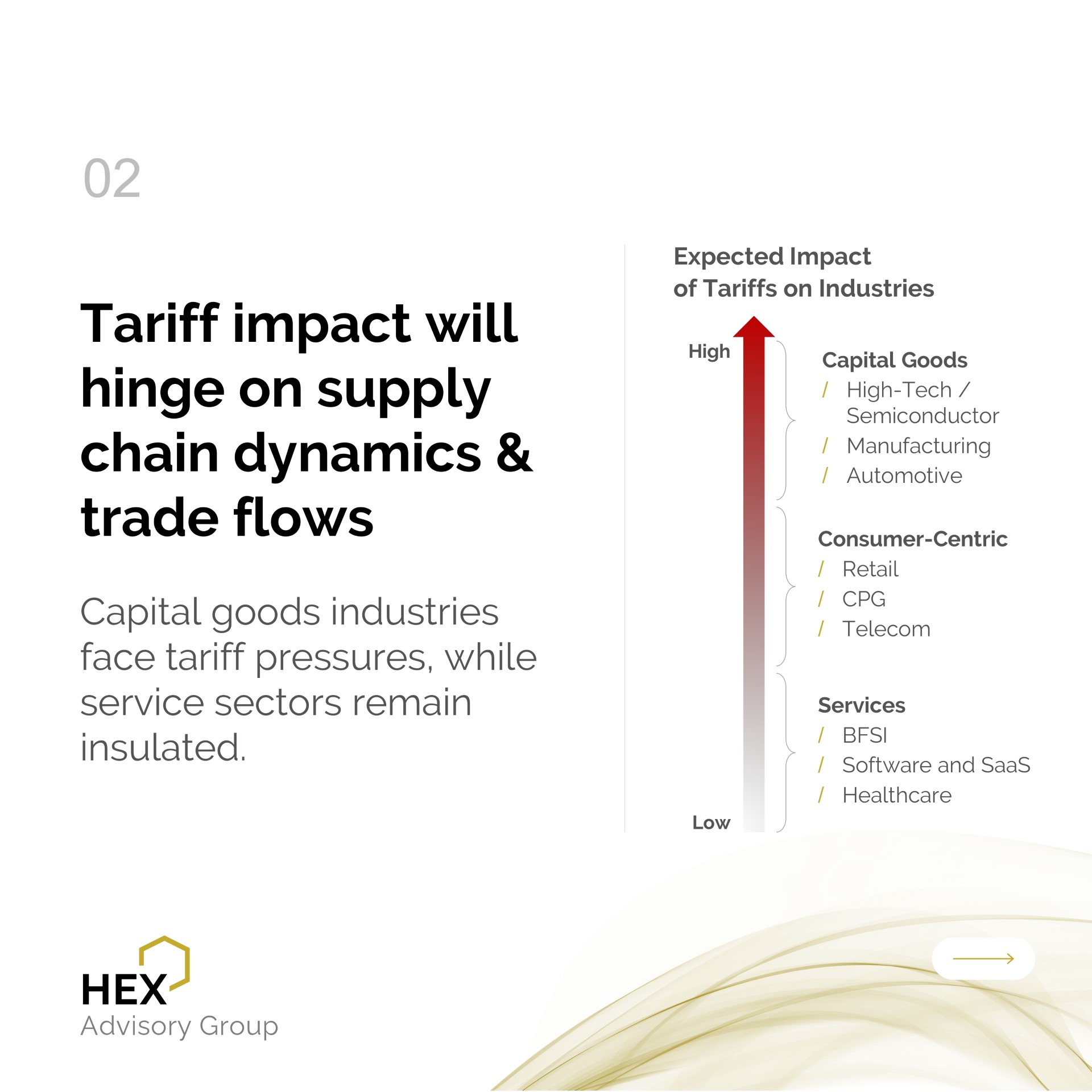
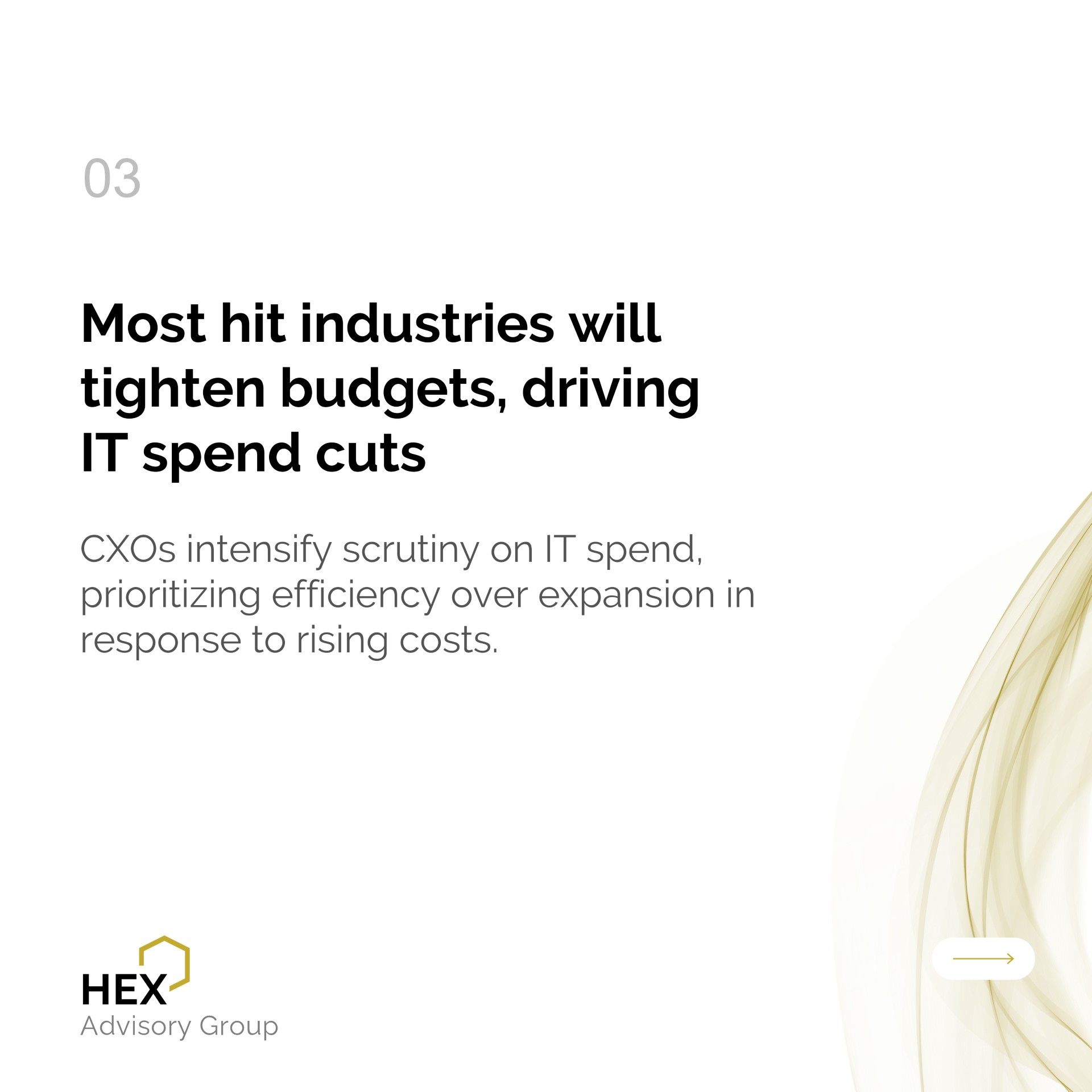



From inefficiency to impact! We streamlined procurement, optimized contracts, and cut costs by 45%.
Find out how: https://hexadvisory.com/contact/#mail
Transforming the way enterprises tackle IT vendor rate compliance! With HEX Index™ Marketplace, say goodbye to pricing inconsistencies and take control of your procurement process.
Ready to level up your procurement? Get started today!
https://hexadvisory.com/contact/#mail
Version 1 just leveled up!
It is now HEX Index™ compliant.
This means smarter, faster, data-driven contract closures for enterprises working with Version 1 on IT, BPO, and GCC mandates—transparent and efficient!
BOT is the laziest, most hands-off way to set up your GCC—your so-called “baby”—in a faraway land. If you’re being misled into an archaic, stifling Build-Operate-Transfer model, then ask yourself:
Would you completely outsource raising your own child—or retain autonomy, with flexible support only as needed?
75% of new GCCs are struggling because of poor GCC enactment by the parent.
Thinking BOT? Think again.
Don’t get locked into rigid commitments—discover tailored GCC solutions built for your success.
Contact us now:
https://hexadvisory.com/contact/#mail
GCC evolution decoded. Here are some of the key pain points and priorities for enterprises at every stage. HEX helps navigate the maturity journey from setup to strategic impact!
Choosing the right IT workforce model is key to balancing cost, control, and scalability. HEX helps you optimize your staffing strategy.
Kerala is stepping up as a key player in the GCC growth story! Known as God’s Own Country, the state is fast emerging as a prime destination for business and innovation. Exciting times ahead!
Honored to be invited to the Kerala Invest Summit, where HEX joined a high-impact GCC roundtable. HEX’s Sarthak and Akash had insightful discussions with key government and industry leaders on Kerala’s growing role in the GCC ecosystem.
This is HUGE! BlackRock, in partnership with Global Infrastructure Partners (GIP) and Terminal Investment Limited, has agreed to acquire a 90% stake in Panama Ports Company from Hong Kong-based CK Hutchison Holdings Ltd for approximately $22.8 billion. “Transaction is purely commercial, unrelated to recent political news” per Hutchison BUT we all know better : )
HEX Advisory Group’s take on the possible socio-political repercussions of this Panama Canal transaction as follows:
This acquisition is a game-changer, reshaping global politics, economics, and diplomacy in a volatile socio-economic global landscape.
Top-tier results without the hefty price tag. HEX ensures expedited sourcing execution, maximizing value at every step.
Explore more: https://hexadvisory.com/contact/#mail
Procurement inefficiencies can drain resources and impact your bottom line. With HEX Index™ Marketplace, enterprises gain access to smarter, data-driven sourcing that enhances transparency, accelerates decision-making, and ensures optimal value realization.
Ready to elevate your procurement strategy? Let’s connect!
https://hexadvisory.com/contact/#mail
Rebadging deals often miss the mark due to a clear disconnect between what enterprises need and what service providers deliver. Let’s close that gap and make these partnerships stronger.
Interested in optimizing your rebadging strategy? Connect with HEX:
https://hexadvisory.com/contact/#mail
Better sourcing starts with the right insights. From business cases to contract negotiations, HEX Index™ empowers smarter decision-making in IT and BPS procurement.
Unlock powerful insights—download HEX Index product briefs now!
https://hexadvisory.com/contact/#mail
HEX supports clients in securing government incentives to build a stronger GCC business case.
Just ask HEX:
https://hexadvisory.com/contact/#mail
If GCC execution is on your mind, then block time with our GCC Think Tank here:
https://hexadvisory.com/contact/#mail
Does your contract have these contemporary T&Cs?
To learn more, get in touch with HEX:
https://hexadvisory.com/contact/#mail
Is Your Service Desk Falling Behind?
Identify the signs of inefficiency before they impact your operations.
Are you experiencing these challenges?
We can help:
https://hexadvisory.com/contact/#mail
Tired of seeing value slip through the cracks in your procurement? Discover how HEX Index™ Marketplace can help you eliminate value leakages and drive savings.
Achieve your procurement goals:
https://hexadvisory.com/contact/#mail
Struggling to fund your Global Capability Center? HEX offers a solution.
We restructure your IT portfolio, eliminate inefficiencies, and help establish 100% self-funded GCCs.
Ready to optimize?
https://hexadvisory.com/contact/#mail
Strategic GenAI sourcing starts with smart decisions: front office drives autonomy, back office fuels efficiency—unlocking enterprise value with GCCs.
Catch Sarthak Brahma sharing more insights on GCCs at the HFS India Summit on February 13.
Don’t miss it!
Here is a sneak peak into our client’s Service Desk transformation journey balancing resiliency and innovation, leveraging a Lift-Shift-Transform approach with phased progression from Transition in 0-4 months, pure Lift and Shift in 4-16 months, to full Transformation beyond 16 months.
Explore how we can help drive this transformation for your enterprise:
https://hexadvisory.com/contact/#mail
Catch Sarthak Brahma sharing more interesting insights on GCC in the much-awaited HFS Research India Summit on February 13 in Bangalore.
If Global Capability Center execution is on your mind then block time with our GCC Think Tank here:
https://hexadvisory.com/contact/#mail
Advance your IT and BPO Sourcing needs without long-drawn RFPs and pay-for-play vendor practices, both of which serve only one entity – the sourcing advisor. Executive leadership in global corporations trust HEX with their Sourcing & Shoring mandates for our objective, high-fidelity, and expeditious execution.
Connect with our Think Tank by clicking here: https://lnkd.in/drhVgGre.
Discover our negotiation prowess that led to a 33% for a Global Capability Center contract with the ‘ .
If GCC execution is on your agenda, reserve your spot with our GCC Think Tank, the . https://lnkd.in/drhVgGre
Caught in the AI maze with diminishing returns and regulatory red tape? At HEX Advisory Group, we unlock your barriers and blueprint your journey to exponential growth. We ensure your offerings not only scale but also innovate.
Engage with the thought pioneers at HEX Advisory Group’s Think Tank. We are the industry’s intellectual vanguard.
Dive into the future with us at https://lnkd.in/drhVgGre.
Connect with HEX Advisory Group’s Think Tank – Sourcing, Shoring, and Benchmarking practitioners in the – . https://lnkd.in/drhVgGre
Connect with HEX Advisory Group’s Think Tank – Sourcing, Shoring, and Benchmarking practitioners in the – . https://lnkd.in/drhVgGre
If Global Capability Center execution is on your mind then” ” with our GCC Think Tank here: https://lnkd.in/drhVgGre
If Global Capability Center (GCC) execution is on your mind then ” ” with Sarthak Brahma and HEX Advisory Group’s think tank https://lnkd.in/gJJGkeRk
If Global Capability Center execution is on your mind then” ” with our GCC Think Tank here: https://lnkd.in/drhVgGre
Time for a Woman to lead the Free World. Its amply clear that the world has had its fill of egomaniacal men at the helm. Voting based on personal agendas, biases, fears, and predispositions just makes us one of them.
If Global Capability Center execution is on your mind then” ” with our GCC Think Tank here: https://lnkd.in/drhVgGre
Click to subscribe and stay updated with our perspectives!
Advance your IT and BPO Sourcing needs without long-drawn RFPs and pay-for-play vendor practices, both of which serve only one entity – the sourcing advisor. Executive leadership in global corporations trust HEX with their Sourcing & Shoring mandates for our objective, high-fidelity, and expeditious execution.
Connect with our think tank by clicking here.
We at HEX are excited to connect with Europe’s top IT procurement and sourcing heads at the IT Procurement & Sourcing Summit 2024 in Amsterdam on . As your trusted sourcing advisors, we bring 100% data-driven insights, powered by our proprietary ™ —an invaluable tool for benchmarking decisions based on over a decade of real transaction data.
Don’t miss the opportunity to discuss how we can drive your IT procurement strategies forward. , fill out our contact form, and let’s secure some time to discuss how we can support your next big move.
Your future sourcing decisions could be a PING away! We’re just a form away, so lock in your spot and let’s explore how HEX Advisory Group can empower your procurement strategies!
The Federal Reserve System just announced an aggressive interest rate cut of 50 basis points on the back of last week’s rate cuts by European Central Bank, inflation nearing 2% (same as in EU and UK), and 12% YTD gas price reduction.
However, wage inflation is still trending high, especially in unionized sectors. Unemployment is still at 4.4% (neither bad nor good), and we will never go back to the days of easy money, i.e., Trillion dollars of bonds selling at negative rates.
And therein lies a potentially big issue looming over Corporate America.
Most American companies borrowed heavily on longer-term 3-5-year low-rate deals in 2020 and 2021, BEFORE the Fed tightening cycle got underway (this also showed in the strong S&P 500 performance during the high-interest period to date). These low-interest deals are set to expire in 2024-2026 and will now face refinancing at 5.5%-6%, a staggering uptick to the borrowing costs on the books for Corporate America – most prominently in the Manufacturing sector.
Final say (reality is more than meets the eye):
Feel free to talk to Sarthak Brahma, Day 2 Chair at IT Procurement & Sourcing Event Series Events Europe, about our multi-million IT Portfolio Optimization, IT Benchmarking, Global Capability Center, GCC Execution, and HEX Index mandates for Airlines, Healthcare, Energy, Automotive, Logistics, Manufacturing, and Banking clients in Europe, Nordics, USA, Australia, and India.
Also, feel free to stop by HEX Advisory Group’s Booth #7 to get acquainted with swift and smart consulting, not the long-drawn, self-serving, and shallow advisory cycles or theoretical Research that one fears. Cheers!
The REAL McCoy of Benchmarking. REAL Transactions Data curated by REAL Sourcing Practitioners.
Block time with Sarthak Brahma to know more.
The REAL McCoy of Benchmarking. REAL Transactions Data curated by REAL Sourcing Practitioners.
Block time with Sarthak Brahma to know more.
HEX Advisory Group is pleased to announce a strategic alliance with HFS Research. This alliance brings together the industry’s best minds and the unparalleled power of the HEXIndex™ – the most authoritative benchmarking tool for global IT-BPS contracts. We are committed to delivering seamless advisory and benchmarking services to our combined client base. Enterprises demand the most balanced research and the best benchmarking. You don’t get both anywhere else…
It’s time you plug in HEX Advisory Group in your business ecosystem.
We may do well alone, but with others we can become spectacular. We find our allies, partner with them, and become more of who we are. Learn the Benefits of Our Alliance HEX Advisory Group HFS Research.
Download our ITO, BPO & COST HEX In product briefs now.
At HEX, we don’t engineer farcical trends. Our benchmarks are what we commit to secure for clients and what we secure become our benchmarks.
We are thrilled to announce our strategic alliance with the HEX Advisory Group, a leading purveyor of global IT–BPS advisory intelligence and support on demand. Through HFS’ access to the HEX Index™—the authoritative benchmarking tool for global IT–BPS contracts—clients will get to experience a seamless extension of the advisory and price benchmarking services arm at HFS Research.
As leaders in our respective domains, we have joined forces to provide our clients access to highly experienced benchmarkers and seasoned IT–BPO sourcing practitioners. This strategic alliance brings together the unrivalled expertise in price benchmarking and advisory services of both entities to deliver cutting-edge advisory services to our clients.
Enterprise heavyweights rely on proven Sourcing & Benchmarking heavyweights for their critical mandates.
HEXIndex is the SINGLE LARGEST SOURCE of sourcing transactions and benchmarking datasets from the pre-pandemic years to the current and ongoing.
HEXIndex is the ONLY benchmarking tool in the IT BPO sourcing industry wherein the data sources and data curators are NOT questionable.
Enterprise CXOs and Vendors see the very same HEX Advisory Group senior sourcing advisors (incl. Sarthak Brahma) execute the enterprise sourcing mandates and contracts and also curate / represent the HEXIndex benchmarking tool. NOWHERE in the industry is a line of sight between referenceable CXO clients / engagements and benchmarks this clear.
Benchmarking is ONLY as defensible as WHO you partner with and HOW you approach it. Don’t believe us, just ask our HEX’ed clients 🙂
While India continues to be the hotbed for GCC setups, CostaRica is increasingly our favored location for nearshore GCC build-outs. CINDE – Experts in FDI and local partners like Feuji Inc continue to be invaluable for our CXO clients and us.
HEX Advisory Group is the leading hands-on advisor in the GCC space. Action NOT Analysis-paralysis. In fact, we – it is hygiene and implicit to our expedited GCC Solution-to-Build lifecycle.
Learn about the 5 trends that are currently shaping the outsourcing industry. You don’t want to miss this!
To engage with HEX Advisory Group’s think tank click here.
Service Providers use financial engineering tools like discounts and credits to make deals lucrative. In many contracts, the service provider and the client contribute an amount towards innovation fund. These funds are utilized to carry out innovation projects that may include automation, digital solutioning, transformation, among others.
Feeling like Existing hashtag#ITBPS ” are your business ?
Time to plug in ᵀᴹ
Engage Now: https://bit.ly/4b5SJrp
Still relying on research/poll-based data and inexperienced analysts? Switch to ™ and harness the power of the most authoritative benchmarking platform curated and maintained by seasoned sourcing practitioners.
To know more click here.
Navigating the intricate landscape of Population Health Management (PHM) pricing demands more than just numbers—it requires expertise. With over 60% of healthcare organizations already on the PHM journey and the market set for substantial growth, the stakes are high. Let us be your guide in unraveling the complexities of PHM investments.
Today marks the one-year anniversary of HEX Advisory Group, and we couldn’t be more thrilled. We want to take a moment to express our gratitude to everyone who has shown us support throughout this journey. As we reflect on the year, we would also like to share some of our proudest accomplishments.
A 10 WATT Human Brain has more cognition than the largest LLM on the planet i.e., OpenAI GPT-3 that is possibly powered by HUNDREDS of MEGAWATTS of GPU Clusters. (Refer screenshot on yet another example on how ChatGPT can get outfoxed with simple queries that require non-linear thinking / solution that a 5-year old’s brain can judge and reason).
So, I hope that you’ll excuse HEX Advisory Group for being a GenAI believer but NOT a GenAI trumpeter in 2023 for good reason. We pride ourselves in solving present-day problems for our CXO clientele while staying plugged into the present continuous themes – not rushing to cash-in on the buzz.
P.S. Jet-lagged and toying with ChatGPT at 5am while in India for yet another GCC recon, this time for a Fortune100 Aviation client.
Objectivity may sting but it doesn’t hurt like bad advice.
Block our time to know how can we help you at HEX Advisory Group:
https://hexadvisory.com/about/#book

While analysts may have you believe that deal sizes increase due to vendor consolidation, we as advisors at HEX are assisting clients first-hand with vendor consolidation mandates targeting 20-25% spend reduction via effort elimination, hyper-automation, right-sizing, right-pricing, and 3rd-party Op-model and contractual transformation.
Rampant poaching and salary splurge in 2021-2022 is beginning to hurt IT providers in a price sensitive 2023. The Cost to Revenue per Employee is still off the charts prompting the providers to recalibrate their hiring and compensation strategies.
To read more perspectives from HEX Advisory Group click here.
Still relying on research/poll-based benchmarking data for optimizing your contract? It’s time to switch to HEX Index data created and maintained by seasoned resourcing practitioners.
Engage with us here: bit.ly/HEXINDEX
Anyone can run an RFP dog and pony show with multiple bidders. This is a lazy, long-drawn, expensive, and self-serving way of running a sourcing program. Instead, HEX Advisory Group has the chops to expeditiously secure contemporary solutions, modern contracts, and competitive commercials with any vendor/s by drawing upon its senior practitioners, recent transactions’ benchmarks, and clearly defined end-states.
To know more click here.
Enterprise sensitivity towards disruptive technology, cost, performance, contractual and governance efficiencies is heightened. Pro-incumbency sentiments observed in 2021-22 has reversed and any lagging incumbent is on the chopping block.
To know more click here.
While solution & technology underpinning continues to be a hygiene expectation, enterprises have become much more sensitive to pricing, T&Cs, and governance when choosing their providers.
To know more click here.
Whether you’re building resources from scratch, transforming practices, or fine-tuning current direction, evaluating the effectiveness of training and its impact on learners and business KPIs can be complex.
Hex’s Advisory Services offer insights and solutions to address critical needs, ensuring that your training investments yield performance improvements and maximize ROI in the short and long term.
To know more connect with us here.
Instituting and monitoring the right KPIs helps streamline IT Operations & Budget.
HEX is helping CFOs, CIOs, and CTOs across USA, EU, and APAC to evaluate, recast, and secure the Health of their IT operations.
To know more click here.
Why Should You Consider Benchmarking with HEX Advisory?
HEX Advisory Group’s Benchmarking Advisory Services & Tools are a unique capability in the IT-BPO industry, integrated into our Sourcing Advisory practice and powered by actual sourcing deal data. It is managed by our senior sourcing advisors, NOT inexperienced research analysts or consulting back-offices.
To know more click here.
Businesses are increasingly adopting SD-WAN to enhance their network infrastructure, streamline their operations and unlock cost savings.
Uncover the adoption triggers and sourcing models of SD-WAN to empower your business to make informed networking choices.
To know more kindly click here.
Automation is not just a buzzword in revenue cycle management—it is a transformative force that is driving healthcare organizations towards a future of enhanced productivity, reduced costs, and improved financial outcomes.
To engage with us click here.
Avoid tacos at 7-Eleven and coffee at Taco Bell. Source matters in everything you consume and that applies to Sourcing and Price Benchmarking trends too.
Don’t ask an advisor what the size of ChatGPT in sourcing deals will be in 2025 and don’t ask a researcher how best to calibrate your multi-million-dollar contracts. You are bound to be misled in either case.
There’s so much broad stroking on IT-BPO Sourcing & Pricing trends going around that I decided not to write a blog post but a MANIFESTO! 🙂
In a BOT model, service provider runs operations in initial stages with an option to transfer back to buyer later. While the operational risk lies with the provider in a BOT model, buyer should staff its employees in all the relevant management layers.
During and post-pandemic, Talent is among the most secular agendas across all firms pan industries. And as firms are scrambling to get the appropriate talent onboard, recruitment process operation is the backbone to execute the talent strategy. As a result, recruitment process outsourcing (RPO) industry has been seeing a sharp growth especially post H2 2021.
A combination of factors are in play that influence enterprises to outsource their recruitment processes.
As a result of the increasing complexity of the health plan environment, coordination of payments to multiple parties and a wide range of government and private health plans remains a challenge. Payment Integrity solutions are reducing the rising healthcare waste and fraud to ensure that claims are paid correctly, free of leakages. Using advanced analytics and data mining, patterns are identified across billions of lines of claims to predict errors in claims, thereby helping firms to reduce waste and focus on value-based care for patients.
We see broadly three types of engagement models in the Payment Integrity space:
What you control is governed by the metrics you measure and report on. But are the right metrics being measured? Traditionally, the functional and back-office metrics have been linked to the respective functional areas and the linkage to enterprise objectives, if at all, may not be evident. The Business Level Agreements (BLAs) framework can help fill this vacuum and ensure that the reported metrics are linked to the business priorities.
Some of the typical BLAs used in F&A processes:
A well thought out set of BLAs is a great mechanism for the support functions (and service providers) to see their impact on the business and the other way round. Enterprises are increasingly embedding these in the contracts to drive risk-sharing and partnership behaviours.
This is an output-based pricing model wherein the fees structure is based on the transactions / Resource Units (RUs) handled. Buyers should consider this model in the following scenarios:
SASE is an emerging technology and organisations must look at it as a journey rather than viewing it as a product. SASE converges the functions of network and security solutions into a unified, global cloud-native service. A SASE solution is meant to provide complete session protection, regardless of whether a user is on or off the corporate network.
The SASE solutions require investment in points of presence and extensive network coverage and on a maturity curve, only an absolute need to put security in the cloud should motivate to consider this as of now; the ecosystem is evolving very rapidly though.
SD-WAN allows for more agile ways of working and improves site availability through simplified and faster failover and relocation of traffic. It helps optimize costs as once implemented, it allows for better aligned demand and supply model to reduce underutilised assets and increase efficiencies as well as utilise a range of cheaper underlying connectivity.
While it offers benefits of technology-agnostic overlay and dynamic routing, without a clear strategy and transformation plan, many of the SD-WAN benefits can be limited or lost such as the ability to consolidate multiple network functions in a single platform.
Virtual captives are increasingly becoming an acceptable solution as they occupy a median position in a spectrum that is occupied by third party outsourcing on one end and captives on the other. For the mid-market enterprises, who end up experiencing a ‘small-fish’ syndrome with large third-party providers and captive remains a pipedream due to lack of capital/appetite, virtual captive offers best of both worlds. It is essentially a hybrid model wherein a local provider will provide all the necessary infrastructure (managed facility, hardware, connectivity etc), talent (sourcing, recruitment & HR), compliance and support services (accounting, compliance, IT operations) while letting the client retain full control of the operations.
Some of the specific advantages this sourcing model offers
Contracts with remit ranging from managed services to supporting Digital Transformation need to clearly delineate the solution and the underlying people and commercial construct. The Capacity and Capability charters are very distinct and painting both with the same brush can lead to a less than an Optimum outcome for both parties.
In this hyperinflationary environment, COLA, once a standard provision, is gaining increasing prominence. And rightly so, as a typical managed services contracts spans 5 years and a robust COLA mechanism/clause that protects the interests of both parties is critical to an equitable contract. It is also in the interest of both Buyer and Seller to include a Benchmarking clause that allows potential commercial ‘reset’ in an uncertain business environment.
Field Service productivity is impacted by SLAs and the underlying support model. The primary driver for productivity is strong emphasis on ticket elimination and “shift-left” of the issues. Productivity can be increased by reducing field service engineers’ intervention. In order to achieve this, service providers can consider strengthening the L1/L1.5 Support with tenured resources to maximize resolution at that level. Furthermore, providers can also consider leveraging following mechanisms to enhance efficiency:
Typically, first gen outsourcing deals / legacy environments have calls and emails as predominant contact channel and proportion of calls and emails could potentially exceed 80-90% of the contacts. However, as service providers rationalize the workflow and implement chat bot and other tools, proportion of calls and emails gets reduced in favour of other channels e.g., chat and web with lower cost to serve. In an end state, service providers may have 60-75% of contact volume by web and chat and remaining 25%-40% by phone calls and emails.
Our advice to enterprises and service providers is to leverage/ contextualize the benchmarks depending upon scope of services and not to have pre-emptive bias for or against any industry. Simply speaking, if scope is a horizontal such as a multi-tower infrastructure deal with its own baselines and environment maturity, then that should drive the benchmark reference set agnostic of industry. However, if we are talking about industry specific scope e.g., payer platform or trading platform support, we’ll need to consider industry specific benchmarks.
Productivity gains and automation impact over the deal term is driven by environmental maturity.. To assess the potential productivity gains, a detailed analysis of number and nature of issues in the current environment is required. We would typically expect overall productivity gains as well as speed of realizing productivity gains to be higher in a legacy (1st time outsourcing) environment v/s 2nd/ 3rd Generation outsourcing deals.
The heated demand is leading to a drive for talent thereby heating up the salaries in onshore and offshore geographies – thereby increasing the cost to serve for Consulting service providers by as much as 10%-20% on a fully-loaded op-cost per FTE basis depending on the underlying technology type and resource seniority. However, enterprises remain cautious and price sensitive on consulting spend and >80% of consulting engagements have some form or fashion of line-of-sight into tangible outcomes / impact.
Currently, the preferred pricing models for S&C are fixed fee based for clearly ring-fenced scope, outcomes, timelines, and with contractual flexibility to pause and/or terminate. Enterprises are also open to risk-gain share mechanisms BUT should be tread with utmost clarity and thought on scope due-diligence, underlying assumptions, dependencies, and outcome versus risk thresholds, else can be detrimental to an already diminishing margin turf for service providers.
Since the cost to serve for S&C is expected to remain elevated in the near to medium term, this segment of business is expected to see margin pressure. A negative margin scenario is only to be expected if providers do not push for a well-defined scope or outcomes, do not size/solution the effort and staffing accurately, or undercut strategically or competitively for downstream execution-led gains. Opportunistically leveraging the perceived ‘premium and niche skills’ market can offer consulting providers with some margin-cushion at a deal-level.
There is an increased enterprise propensity in the market for committed outsourcing outcomes and the same is manifesting itself in increased instances of outcome-based pricing contracts. However, what construes as “outcome” can vary across contracts. Some points to note:
Therefore, the definition of “outcome” may vary, but the model is expected to sustain and gain momentum across contract types.
In managed services contracts, we continue to draft up and get equitable agreement for a 3.0%-3.5% global COLA i.e., applicable to the managed services delivery model incl. the underlying global delivery location portfolio agreed by both parties. The expectation is that the above 3.0-3.5% should be explicitly stated as part of the fee assumptions but needs to be pre-baked into the Y1-Y5 ACV’s i.e., no fee changes during the initial contract term. This incentivizes / encourages the provider to offset COLA against automation-led benefits in the out years, staffing mix and on-offshore mix changes during the contract term etc.
Besides the managed services component, there is typically the project rate card i.e., T&M component in the pricing exhibits. Typically, COLA is applied starting Y3 of the deal & can have higher exposure than managed services COLA i.e., in the 3-5% range depending on skill sets. COLA is subject to the benchmarking clause i.e., if either party wishes to invoke the benchmarking clause to sense-check any significant rate/market changes if the contracted COLA is unacceptable by either party when the need arises
All providers are concerned about the wage inflation, which while real for experienced/lateral hires, needs to be contextualized in the scope of a typical IT-BPS managed services delivery solution. Fact is that the entry-level salaries have remained consistent for the last many years and the same is true even now. Plus, all providers are pushing their entry-level pool to Tier2/3/4 locations and colleges to keep this entry-level cost base consistent, and this is where most providers expect to build 70-80% of their incremental seat capacity esp. with the remote model – most providers have alluded to this in recent quarterly earnings strategies as a margin retention measure. In addition, in a typical delivery AO/IO/BPO pyramid, 75%-80% of the resources are in these bottom two rungs wherein the compensation is being held steady. So, the talent war and the heated 20%-40% wage hikes for experienced hires only applies to 20%-25% of the wage pyramid i.e., 4%-10% net wage increase on a blended wage pyramid. However, wage / compensation is ~50% of a fully loaded offshore rate card (other components being real-estate, telecom/technology, consumables, SG&A, op-margins), therefore, the net offshore rate card impact of blended wage increase is halved to 2%-5%. Now, offshore is typically 80%-90% of the offshore-onshore managed services delivery. Therefore, the net service delivery impact of COLA in a global managed services contract is 2.5%-4.5% and with this rationale we manage to close the agreement at 3.0-3.5% global COLA on equitable and transparent footing.
The mega deals market (>$100M TCV) is shrinking. In general, enterprises are reconsidering large scale transformation investments, breaking down larger programs and staggering them over budget cycles based on priority or predictable RoI. Exceptions may be seen in the Telecom, Transportation, Utilities, Mining, and Energy verticals spurred by the infrastructure spending bill.
Small to mid-sized deals market ($5M – $15M ACV) will continue to see momentum driven by bite-sized initiatives, cost and operations focused mandates, and mid-cap enterprises coming out of the woodwork to sustain their business in a tightening liquidity market. Nearly 60% of new deal value is expected in this segment.
Providers will need to reevaluate their sales strategy – do they invest resources in chasing the few large deals involving long spin cycles or get better at closing smaller deals with shorter spin cycles.
One still sees so many enterprises locked in long term contracts, punitive termination penalties, proprietary technologies, and inflexible financials. Such relationships are the ones where there is seldom any innovation. The provider sees no additional gains to be made from a client stuck in one’s chair whereas the client sees no reason to invest more resources in a lopsided arrangement – and the relationship plummets.
But in an industry so interconnected and stakeholders so transient, the word gets out. Such troubled accounts become competitive targets and the provider starts losing ground. That’s the thing – a contract can have lock in, word of mouth doesn’t.
This may be a bit of memory jog as this is not about the automation BOT that has been the top of mind recall in recent times but rather the good old, Build-Operate-Transfer (BOT) that is making a quiet but definitive comeback to the boardroom discussions. During the pandemic and post ‘The Great Resignation’, firms have and are continuing to de-risk their alternate service delivery models. As part of this, enterprises are increasingly assessing and executing BOT transactions. The drivers for them to do this are multifold e.g., deleveraging third-party outsourced portfolio, managing sensitivities around product development, building digital talent inhouse etc. While the classic BOT remains intact, its close variant, Virtual Captive, is increasingly gaining traction as this model offers a good balance between ‘Control’ and ‘Risk’. The supply side is becoming increasingly mature and arming their portfolios with innovative and agile ‘as-a-Service’ solutions.
Next time, when you are looking beyond Managed Services but do not just have the appetite for own captive, definitely worth adding this to the list of options. Lets you ‘test-drive’ offshore on a ‘Pay-as-you-grow’ model.
Know more about our GCC Lifecycle Advisory Services
Yes, the global growth sentiment is bearish—painful inflation, stocks nosediving, supply chain bottlenecks, war, and whatnot. Why take-on additional risks of switching vendors, reopening contracts, and teasing transformation in this climate, correct? Correct! But have you set boundaries for your comfort zone? Because, if you have not then chances are that you are blurring the lines between that of a practical bear and that of a victim.
Nearly 70% of the IT-BPS transactions that our advisors managed recently were sole-sourced or incumbency vendor renewals / rescoping. Fewer than 20% of these sole-sourced transactions rightfully became competitive when solutioning inertia, contractual impasse, or commercial impracticality was met. In the rest, the enterprises buckled. They sought refuge in notional improvements, tactical promises, and basis point benefits in the face of facts and figures.
Any relationship is worth sustaining and that applies to the contractual kind. However, if you do not set boundaries, you will never know when to rightfully step out. And that is just damaging, no matter the climate.
Maturity of outsourcing contracts on the ground has lagged the analyst talk. We have observed that service providers are incorporating elements of analyst spiel and transformative agenda as part of their pitches while their existing contract are struggling with the basic transactional issues. It is imperative that service providers need to bridge gaps in capabilities around the base or fundamental services as they look to build next gen capabilities and incorporate them as part of pursuits and solutions.
Providers can get fixated with what they consider as value differentiators instead of understanding what the client’s value definitions are. Over the contract lifecycle, the value gap only tends to increase. With the anti-incumbency trend at its peak, Providers can benefit with a neutral and holistic assessment of existing client relationships to proactively cement and expand the account
A misalignment in the value definition between Service Provider and the enterprise leads to significant gap between the value delivered by provider and value realized by client. This gap only gets amplified over the contract life cycle.
In our experience, the value gap is driven by:
Benchmarking is an integral part of any contract evaluation for reassurance of the value on offer. However, for the benchmarking exercise to deliver real and meaningful value, it is important to have a holistic benchmarking approach in partnership with experienced advisor with access to relevant data with context details as well as practical deal experience.
With the increasing need for contractual and financial flexibility, financial engineering has become more important than ever in outsourcing contracts structuring. In our experience, winning bids reflect flexibility to align with buyer motivation.
Typical buyer considerations could include:





Is your “independent” advisor a pay-to-play conduit? – siphoning money from hopeful vendors while working on your enterprise dime?
It’s necessary to check for hidden strings when you choose an advisor.
Source: LinkedIn
Cognitive automation isn’t the future, It’s the now (thanks to AI)
If your workflows still wait for instructions, they’re already obsolete.
Source: LinkedIn
Sole-sourced deals don’t have to bleed value.
Vendors may price with impunity, but with the right benchmarks and negotiation expertise, you can secure competitive terms, faster turnaround, and significant savings.
Here’s how HEX helped one of the world’s largest hospitality chains achieve market-aligned pricing, equitable terms, and expedited results.


Presenting Part 3 of our series — “Executive Cheat Sheet on T&Cs” — your no-fluff guide to Contracting 101. We break down dense terms and conditions into what they actually mean, why they matter, and how they impact your IT and BPO deals.
This week’s focus: Step-In Rights




Recent trends are redrawing the battle lines in Mid Market Deals.
Bridge the gap with insights that anticipate the shift. Stay ahead or risk falling behind.
When your advisor recommends a vendor circus, it’s not strategy, it’s showbiz (and billable hours). At HEX, we cut through the noise.







This breakdown of GCC providers helps you assess who truly delivers across key dimensions like setup, strategy, and operations.
Are you evaluating your GCC provider with the right lens? Let’s discuss.
Let’s talk: https://hexadvisory.com/contact/#mail
HEX has won every solution-centric enterprise conversation against big consulting this year—across Large Cap, Mid Cap, and PEPortcos.
Like us, our Sourcing solutions are radically commonsensical, outrageously fast, and implausibly tangible. We don’t chase logos—we build peer advocacy.
Still running on hold music and manual tickets?
It’s time to replace phone queues with bots, AI, and self-heal.
Want to modernize your service desk?
Let’s talk: https://hexadvisory.com/contact/#mail
GCCs in Tier 2/3 cities aren’t the next big thing — they’re already in play. Your GCC doesn’t have to follow the Tier 1 crowd, it can lead the shift.
HEX can show you where: